| |
 |
 |
| |
| East Caribbean
States |
| |
The Eastern Caribbean
dollar (symbol: $; code: XCD) is the currency of all six full members:
Antigua and Barbuda,
Dominica, Grenada,
Saint Kitts and Nevis,
Saint Lucia, and
Saint Vincent and the
Grenadines and two associate member (British
overseas territories): Anguilla and
Montserrat of the Organisation of
Eastern Caribbean States (OECS). These states are all members of the Eastern
Caribbean Currency Union. The other two associate members of the OECS do not
use the Eastern Caribbean Dollar as their official currency: the British
Virgin Islands (uses: US Dollar) and Martinique (uses Euro). The Eastern
Caribbean Dollar is successor to the British West Indies Dollar, it has
existed since 1965, and it is normally abbreviated with the Dollar sign $
or, alternatively, EC$ to distinguish it from other dollar-denominated
currencies. The EC$ is subdivided into 100 cents. It has been pegged to the
United States dollar since 07 July 1976, at the exchange rate of US$ 1 = EC$
2.70.
In 1951, the British Virgin Islands
adopted the British West Indies dollar which at that time operated in
conjunction with the sterling coinage, and in 1959 they changed over
officially to the U.S. dollar.
British Guiana (now Guyana)
and Barbados had
previously been members of the Eastern Caribbean Currency Union but withdrew
in 1966 and 1972, respectively. Trinidad and
Tobago had been a member of the earlier British
West Indies currency union, but withdrew in 1964. |
| |
| |
|
British West Indies coinage: 1820-1822 |
| Currency: Anchor
Dollar [1820-1822]. |
| Queen Anne's proclamation
of 1704 introduced the gold standard to the British West Indies, putting the
West Indies about two hundred years ahead of the East Indies in this
respect. Nevertheless, silver pieces of eight continued to form an important
portion of the circulating coinage right up until the late 1870s. During 1820-1822,
the British government coined 1⁄4, 1⁄8, and 1⁄16 fractional 'Anchor
dollars' for use in Mauritius and the British West Indies (but not Jamaica).
1/2 Dollar was introduced in 1821-1822. A few years later copper fractional dollars were coined for Mauritius,
Sierra Leone, and the British West Indies. |
| |
|
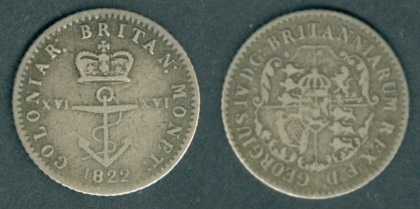 |
KM#1 1/16 Dollar. Year:
1822. Weight:
1.56g [1.74 g]. Metal:
0.892 Silver.
Diameter:
15.75 mm.
Edge: Reeded. Alignment:
Coin. Mint:
British Royal Mint, London, UK. |
|
Obverse:
Crown above Anchor in the center. "COLONIAR:
BRITAN: MONET:" (translate:
Colonial money of Britain) written in circular form,
near the edge. "XVI" (16) written on both sides of the Anchor. Date "1822"
written at the bottom.
Reverse:
Coat of arms on ornate
shield in the center.
"GEORGIVS IV D:G: BRITANNIARUM REX F:D:" (Full
text: GEORGIVS IV DEI GRATIA
BRITANNIARUM REX FIDEI DEFENSOR.
translate: George the Fourth, by
the Grace of God, King of the British, Defender of the Faith) written in circular form,
near the edge.
Mintage:
N/A.
Minted Years:
1820,
1820 Proof, 1820/1, 1822, 1822 overdate variety and 1822 Proof.
Ruler:
George IV. George IV
(George Augustus Frederick; b. 12 August 1762 – d. 26 June 1830) was
King of the United Kingdom of Great Britain and Ireland and King of
Hanover from the death of his father, King George III, on 29 January
1820 until his own death ten years later on 26 June 1830. From 1811
until his accession, he served as regent during his father's final
mental illness.
Additional Note: The ‘Anchor
Coins' do not bear a particular place identification. They were
issued for use in various British colonies in both the New World and
the Orient. Coins of this type dated 1820 are traditionally assigned
to Mauritius and other holdings in the Indian Ocean. Those of 1822
were initially struck for Mauritius but after the introduction of
sterling as the denomination of public accounts in Mauritius, they
found their widest circulation in Canada and colonies in the
Caribbean Sea. In Jamaica they were limited to military transactions
only. In the Leeward Islands they were used on the British islands (Anguilla
+ Antigua and Barbuda + Montserrat + Saint Kitts and Nevis, except
the Virgin Islands), Windward Islands (Dominica + Saint Lucia +
Saint Vincent and the Grenadines + Grenada), Barbados, Tobago and
Trinidad. |
|
| |
| |
| Currency: (1825-1949). |
6 Black Dogs = 4 Stampees = 1 Bit = 9 Pence.
8 Shillings, 3 Pence = 11 Bits = 8 Reales.
108 Pence = 12 Bits = 9 Shillings = 1 Dollar.
100 Cents = 1 Dollar.
6 Livres 15 Sous (15.00 grams cut of Spanish / Spanish Colonial coin) with
Countermark: "S:Lucie" for Saint Lucia. |
| |
Examples of Countermark on French and Spanish coins:
- 1-1/2 PENCE (Black Dog) - Countermark on French and French Guiana,
Colony of Cayenne 2 Sous.
- 9 PENCE (Bit) - Countermark on 1/2 cut of Spanish or Spanish
Colonial 2 Reales.
- SHILLING (1/8 DOLLAR) - Countermark on 1/8 cut of Spanish or Spanish
Colonial 8 Reales.
- 2 SHILLING (1/4 DOLLAR) - Countermark on 1/4 cut of Spanish or
Spanish Colonial 8 Reales.
- 4 SHILLING 1-1/2 PENCE (1/2 DOLLAR) - Countermark on 1/2 cut of
Spanish or Spanish Colonial 8 Reales.
|
| |
Countermark Symbols:
Tortola Island of British Virgin Island, has an area of about 24 sq. mi.
(62 sq. km.), is the largest of 36 islands. Tortola has "T" Countermark on French 2 Sous
coins, "TORTOLA" in odd shaped rectangle, "TIRTILA" and "TIRTILA with
inverted V for A" on Spanish cut coins. Countermark: "S:Lucie" is
known for Saint Lucia. Similarly various small countermark symbols were used by
other British Caribbean Islands. |
| |
The first move to introduce British sterling silver coinage to the colonies
came with an imperial order-in-council dated 1825. This move was inspired by
a number of factors. The United Kingdom was now operating a very successful
gold standard in relation to the gold sovereign that was introduced in 1816,
and there was a desire to extend this system to the colonies. In addition to
this, there was the fact that the supply of Spanish dollars (pieces of
eight) had been cut off as a result of the revolutions in Latin America
where most of the Spanish dollars were minted. The last Spanish Dollar was
in fact minted at Potosi in 1825. There was now a growing desire to have a
stable and steady supply of British shillings everywhere the British drum
was beating. The 1825 order-in-council was largely a failure because it made
sterling silver coinage legal tender at the unrealistic rating in relation
to the Spanish dollar of $1 = 4 shillings 4 pence. It succeeded in Jamaica,
Bermuda, and British Honduras because the authorities in those territories
set aside the official ratings and used the more realistic rating of $1 = 4
shillings. The reality of the rating between the dollar and the pound was
based on the silver content of the Spanish pieces of eight as compared to
the gold content of the British gold sovereign.
A second imperial order-in-council was passed in 1838 with the correct
rating of $1 = 4 shillings 2 pence. In the years following the 1838
order-in-council, the British West Indies territories began to enact local
legislation for the purposes of assimilating their monies of account with
the British pound sterling. Gold discoveries in Australia in 1851 drove the
silver dollar out of the West Indies, but it returned again with the great
depreciation in the value of silver that followed with Germany's transition
to the gold standard between 1871 and 1873. In the years immediately
following 1873, there was a fear that the British West Indies might return
to a silver standard. As such, legislation was passed in the individual
territories to demonetize the silver dollars. Even though the British
coinage was also silver, it represented fractions of the gold sovereign and
so its value was based on a gold standard.
During this period, and into the nineteenth century, accounts could be kept
in either dollars or sterling. Jamaica, Bermuda, and the Bahamas preferred
to use sterling accounts whereas British Guiana used dollar accounts.
British Guiana used dollar accounts for the purpose of assisting in the
transition from the Dutch guilder system of currency to the British pound
sterling system. In the Eastern Caribbean territories the private sector
preferred to use dollar accounts whereas the government preferred to use
sterling accounts. In some of the Eastern Caribbean territories, notes were
issued by various private banks, denominated in dollars equivalent to 4
shillings 2 pence.
In 1946, a West Indian Currency Conference saw Barbados, British Guiana, the
Leeward Islands, Trinidad and Tobago and the Windward Islands agree to
establish a unified decimal currency system based on a West Indian dollar to
replace the current arrangement of having three different Boards of
Commissioners of Currency [for Barbados (which also served the Leeward and
Windward Islands), British Guiana and Trinidad & Tobago]. |
| |
|
"British Guiana and West Indies" coinage:
1891-1916. |
| After the introduction of the dollar, regular
British coins circulated, together with 2 and 4 pence coins also issued
elsewhere in the British West Indies. The 2 pence (in British Guiana, they
were equivalent to 1/8 guilder) coins issued in 1838, 1843
and 1848 were of the standard Maundy money type, whilst the 4 pence coins
bore an image of Britannia. 4 pence coins were issued
specifically for "British Guiana and West Indies" during 1891-1916 and
for "British Guiana" during 1917-1945. By Royal Proclamation of 10
May 1917 the coins were only for British Guiana; the 1917 issue was made on
30 June 1917 (Annual Report of the Deputy Master and Comptroller of the
Royal Mint, 1917 p. 12). |
| |
|
1891 |
| |
|
 |
KM#26 Pridmore 32 Four Pence. Year:
1891. Weight:
1.86g [1.8851 g]. Metal:
0.925 Silver.
Diameter:
16.00 mm.
Edge: Reeded. Alignment:
Medal. Mint:
British Royal Mint, London, UK. |
|
Obverse:
Crown almost at the top position. Value "FOUR
PENCE" written in
two lines within the Oak Wreath in the center. "BRITISH GUIANA AND
WEST INDIES" written outside the Oak Wreath in circular form. Date "1891"
written at the bottom, below the Wreath knot.
Reverse:
Portrait of Queen
Victoria, wearing coronet and facing left in the center.
"VICTORIA" written on the right clockwise. "QUEEN" written on
the left clockwise.
Mintage:
336,000.
Minted Years:
1891,
1894, 1900 and 1901. Engraver:
Leonard Charles Wyon (Queen
Victoria
portrait side).
Leonard Charles Wyon (b. London
23 November 1826 – d. London 20 August 1891) was a British engraver
of the Victorian era most notable for his work on the gold and
silver coinage struck for the Golden Jubilee of Queen Victoria in
1887 and the bronze coinage of 1860 with the second ("bun") head
portrait, in use from 1860 to 1894.
The eldest son of chief engraver William Wyon and his wife,
Catherine Sophia, née Keele (d. 1851), Leonard Charles Wyon was born
in one of the houses in the Royal Mint in 1826, and was educated at
Merchant Taylors' School. L.C. Wyon's father taught him art and also
from his father he inherited great skill in die engraving. By the
age of 16 he had already made several medals and some of his early
work is displayed in the British Museum's Numismatic collection. He
first exhibited at the Royal Academy in 1843. From 1844 he studied
at the Royal Academy Schools and in the same year, at the age of
just 18, he became Second Engraver under his father at the Royal
Mint. One of his earliest medals to be widely praised was his 1846
medal of the Irish Temperance preacher Theobald Mathew. In 1850 he
was commissioned by Queen Victoria to make medallic portraits of the
royal children, and in 1851 he executed the reverse of the
prize-medal for The Great Exhibition. Also in 1851, at the age of
24, he succeeded his father, who had died, with the title of
Modeller and Engraver. In 1854 he engraved the 'William Wyon
Laudatory Medal', in memory of his father, for the Art Union of
London. Like his father before him, he also produced dies for
postage and other stamps.
Wyon submitted a number of designs to the Queen for her approval,
one of which she adopted known as Wyon's 'Bun Head' (Victoria's hair
style) penny introduced in 1860. It shows his initials L.C.W.
beneath Britannia's foot.
L. C. Wyon also engraved the dies for the gold and silver coinage
struck for the Golden Jubilee of Queen Victoria in 1887. This
coinage, the designs for which were prepared from life by Sir Joseph
Boehm, RA, produced a storm of disapproval, directed particularly
against Boehm's portrait of the Queen.
Wyon, like his father William before him, prepared many dies for
coinage use in various parts of the British Empire, including those
for Australia, British East Africa, British Guiana, the West Indies,
British Honduras, British India; the British India Native States of
Alwar, Bikanir, Dwas and Dgar; Canada, Ceylon, Cyprus, Hong Kong,
Jamaica, Jersey, Malta, Mauritius, New Brunswick, Newfoundland, Nova
Scotia, Prince Edward Island and the Straits Settlements. His
official medals included the South Africa Medal (1853), the Arctic
and Baltic Medals, the Indian Mutiny Medal, and the South Africa
Medal (1879). Among his portrait medals are those of William
Wordsworth (1848), Robert Stephenson (1850), Joseph Paxton (1854),
Richard Sainthill (1855), Henry Hallam (1859), and William Ewart
Gladstone (1879).
On 22 June 1852 Wyon married Mary Birks (1831–1902) and the couple
lived in London, first in Maida Vale and from 1856 in St John's
Wood. None of their numerous offspring took up their father's
profession.
At the age of 64, Leonard Charles Wyon died of Bright's disease and
apoplexy at his home, 54 Hamilton Terrace, St John's Wood, London,
on 20 August 1891 and was buried at Paddington Old Cemetery. |
|
| |
|
|
|
British Caribbean Territories - Eastern
Group (1955-1965) |
|
|
|
Currency: British West Indies Dollar = 100
cents. [1949-1965] |
|
In 1949, the British government formalized the dollar system of accounts in
British Guiana and the Eastern Caribbean territories by introducing the
British West Indies dollar (BWI$) at the already existing conversion rate of
$4.80 per pound sterling (or $1 = 4 shillings 2 pence). It was one of the
many experimental political and economic ventures tested by the British
government to form a uniform system within the British West Indies
territories. The symbol "BWI$" for frequently used and the currency was
known verbally as the "Beewee" (slang for British West Indies) dollar.
Shortly thereafter in the 1950, the British Caribbean Currency Board (BCCB)
was set up in Trinidad with the sole right to issue notes and coins of the
new unified currency and given the mandate of keeping full foreign exchange
cover to ensure convertibility at $4.80 per pound sterling. In 1951, the
British Virgin Islands joined the arrangement, but this led to discontent
because that territory was more naturally drawn to the currency of the
neighbouring U.S. Virgin Islands. In 1961, the British Virgin Islands
withdrew from the arrangement and adopted the U.S. Dollar. |
From 1949-1955, the BWI$ existed only as banknotes in
conjunction with sterling fractional coinage. Decimal coins replaced the
sterling coins in 1955. These decimal coins were denominated in cents, with
each cent worth one halfpenny in sterling.
In 1958, the West Indies Federation was established and the BWI$ was its
currency. However, although Jamaica (including the Cayman Islands and the
Turks and Caicos Islands) was part of the West Indies Federation, it
retained the Jamaican pound, despite adopting the BWI$ as legal tender from
1954. Jamaica, the Cayman Islands, and the Turks and Caicos Islands were
already long established users of the sterling accounts system of pounds,
shillings, and pence.
In 1964 Jamaica ended the legal tender status of the BWI$ and Trinidad and
Tobago withdrew from the currency union (adopting the Trinidad and Tobago
dollar) forcing the movement of the headquarters of the BCCB to Barbados and
soon the "BWI$" dollar lost its regional support.
On 06 October 1965, the British West Indies dollar of the now defunct West Indies
Federation was replaced at par by the Eastern Caribbean dollar and the BCCB
was replaced by the Eastern Caribbean Currency Authority or ECCA
(established by the Eastern Caribbean Currency Agreement 1965). British
Guiana withdrew from the currency union the following year. Grenada, which
had used the Trinidad and Tobago dollar from 1964, rejoined the common
currency arrangement in 1968. Barbados withdrew from the currency union in
1972, following which the ECCA headquarters were moved to St. Kitts. |
| |
|
1955 |
| Coins were introduced in 1955 in denominations
of 1⁄2, 1, 2, 5, 10, 25 and 50 cents, minted under the name of "British
Caribbean Territories, Eastern Group". The 1⁄2, 1, and 2 cent coins were
bronze and of the same weight and diameter as British Pound Sterling
farthing, 1⁄2 penny, and 1 penny coins. The 5 cents coin was brass while
the 10, 25, and 50 cents were cupro-nickel. These coins remained in
circulation until 1981, with the exception of the 1⁄2 cent, which was
withdrawn in 1965. All coins bore the image of Queen Elizabeth II. |
|
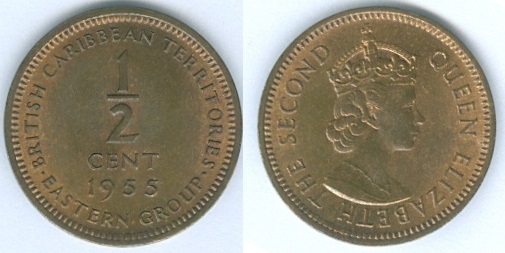 |
KM#1
/ Schön# 1
Half
Cent. Year:
1955. Weight:
2.86g [2.83 g]. Metal:
Bronze.
Diameter:
20.00 mm.
Thickness:
1.25 mm. Edge:
Plain. Alignment:
Medal. Mint:
British Royal Mint, UK. |
|
Obverse:
"BRITISH CARIBBEAN TERRITORIES"
written at the top section. Value "1/2 CENT" written in
the center with Date "1955" below it. "·EASTERN GROUP·" written at
the bottom section.
Reverse:
Portrait of Queen
Elizabeth II facing right in the center.
"QUEEN ELIZABETH THE SECOND" written around
Queen Elizabeth II's
portrait.
Mintage:
500,000 + 2,000 Proofs.
Minted Years:
1955 and
1958. Engraver:
Thomas Humphrey Paget (Value
side) and Cecil
Walter Thomas (Queen Elizabeth II's
portrait side).
Thomas Humphrey Paget OBE (13
August 1893 – 30 April 1974) was an English medal and coin designer
and modeller. Paget's designs are indicated by the initials 'HP'.
Paget was first approached by the Royal Mint in 1936 after the
accession of King Edward VIII. Paget's recommendation had come via
his earlier design for the obverse of a medal featuring the
then-Prince of Wales. After some controversy regarding the direction
the monarch was to face on the coinage (it had been tradition for
each successive monarch to face in the opposite direction to the
predecessor, but the King felt that the features of his left were
better than his right), Paget's work was approved in two slightly
differing designs: one for silver and another for non-silver.
However Edward's abdication meant that, apart from a few trial
pieces, Paget's designs never reached the minting stage. Some did
find their way out of the Mint for testing purposes, and as such
have become amongst the rarest and most collectable pieces of all
sterling coinage.
A measure of the success of the Edward portrait can be seen in the
fact that Paget alone was commissioned to design George VI's effigy
in 1937. He is the only artist to have a second obverse design
approved for use in sterling coinage in the 20th century. The
portrait of George VI has since been described as "the classic
coinage head of the 20th century".
Although principally known as an obverse designer, Paget carried out
some work for reverses, including most famously a design featuring
the Elizabethan galleon the Golden Hind. Originally intended for the
halfcrown, it was adopted for the halfpenny in 1937 where it
remained until it was withdrawn in 1969 (in readiness for
decimalisation in 1971).
He was awarded the O.B.E. (Civil) in the King's Birthday Honours of
1948. His O.B.E. was gazetted in the Supplement to The London
Gazette, Number 38311, Page 3377, published on 04 June 1948. Paget
later designed a wide variety of issues for both Commonwealth and
non-Commonwealth countries. Notable amongst his later work included
an effigy of King Faisal II of Iraq in 1955 and the 1970
Commonwealth Games medal which featured the Duke of Edinburgh. He
also produced an effigy of Queen Elizabeth II for a commemorative
Isle of Man issue in 1965. Paget's work remains part of current
sterling circulation: his 1970 portrait of the Duke of Edinburgh
appears on the reverse of a 2017 commemorative five pound coin.
Cecil Walter Thomas, OBE FRBS,
(03 March 1885 – 16 September 1976) was a British sculptor and
medallist. As a sculptor, he created many private memorials for
display in churches and cemeteries and as a medallist was regularly
commissioned by the Royal Mint.
Thomas was a regular exhibitor at the Royal Academy, starting in
1909, and at the Royal Society of Miniature Painters, Sculptors and
Gravers, of which he became an associate in 1914 and a fellow the
following year. He also exhibited at the Grosvenor Gallery in
London, the Walker Art Gallery in Liverpool, Manchester City
Gallery, the Salon in Paris, and at shows in the United States.
During the First World War, Thomas joined the British Army,
initially serving as a staff officer. He was observed by his
superiors using sand models to demonstrate plans to his men and
transferred to a military intelligence position. He was seriously
wounded later in the war and returned to his medal-making during his
recovery. After the war, he received a commissioned for a recumbent
effigy from a lord and lady, in memory of their two sons. This
resulted in many more commissions for funerary bronze effigies.
Several are on display in churches including All
Hallows-by-the-Tower in the City of London; Christ Church Cathedral
in Newcastle, New South Wales; and Exbury Church in Hampshire. As
well as private memorials, Thomas created effigies of multiple
public figures, including Randall Davidson, Archbishop of
Canterbury, in Canterbury Cathedral; Bishop Edward Talbot in
Southwark Cathedral; Admiral Philip Nelson-Ward at Boxgrove Priory
church; and Reverend Prebendary Boyd in St Alban's Church,
Teddington. He also designed a war memorials for the St John
Ambulance Brigade at St John's Gate, Clerkenwell. He was made a
fellow of the Royal Society of British Sculptors (now the Royal
British Society of Sculptors) in 1938.
Thomas volunteered for the Royal Air Force at the outbreak the
Second World War, serving in the model-making section at RAF
Medmenham in Buckinghamshire, interpreting aerial photographs into
terrain models. He was demobilised in 1945, having reached the age
of 60.
In 1946, Thomas became Master of the Art Workers Guild and in 1953
was appointed an Officer of the Order of the British Empire.
In his later career, Thomas received many commissions for coins and
medals from the Royal Mint. Upon the coronation of Queen Elizabeth
II in 1953, Thomas won the competition to design the new coinage but
in the end his designs were only used on two British coins, the
florin (two shillings) and the sixpence, and Thomas was asked to
refine the designs of other artists. Nonetheless, his designs were
used on coinage in several Commonwealth countries including Hong
Kong and Nigeria. Disaffected by his experience, Thomas declined a
commission to design Britain's post-decimalisation coinage.
Despite his disaffection with coin-making, Thomas continued to
design many medals for the Royal Mint, including the Queen Elizabeth
II Coronation Medal, the Queen's Service Medal (New Zealand), and
seal for Church of England bishops. He also accepted numerous
private commissions. Among Thomas' later commissions were the
Bromhead Memorial in Richmond Cemetery (1957) and several large
bronzes destined for New Zealand, one of was received by King's
College in Auckland; the other two were near-identical sculptures of
Peter Pan. One was commissioned for the Dunedin Botanic Garden
(unveiled in 1965), which inspired the commission for a second one
to stand at Lake Virginia in Whanganui (unveiled in 1967).
Thomas moved into Kensington House, 108 Old Brompton Road in
Kensington in 1919, initially renting the property and later buying
it. He lived there and used the building as his studio until his
death. Thomas died at home on 16 September 1976. His son gifted
Kensington House (by then renamed Dora House) to the RBS to use as
their headquarters and an exhibition space. His collection of proofs
is now held by the British Museum. |
|
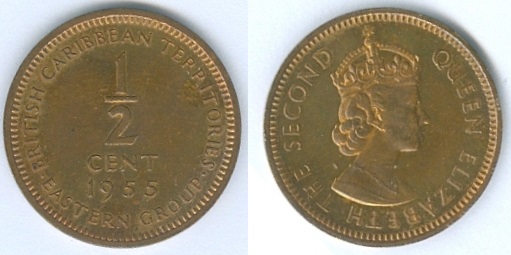 |
Same as above coin, but looks like "Proof issue"
from it's orange colour and attractive details. Weight:
2.84g [2.83 g].
Mintage: 2,000. |
|
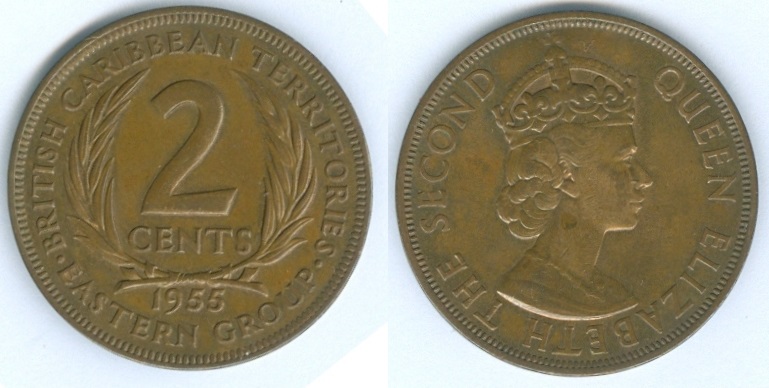 |
|
KM#3
/ Schön# 3
2
Cents. Year:
1955. Weight:
9.43g [9.45 g]. Metal:
Bronze.
Diameter:
30.50 mm.
Thickness: 1.68 mm.
Edge:
Plain. Alignment:
Medal. Mint:
British Royal Mint, UK.
Obverse:
"BRITISH CARIBBEAN TERRITORIES"
written at the top section. Large Numeral "2" in the center with
"CENT" written below it; flanked by palm tree fronds. Date "1955"
written below the palm tree fronds. "·EASTERN GROUP·" written at the bottom
section.
Reverse:
Portrait of Queen
Elizabeth II facing right in the center.
"QUEEN ELIZABETH THE SECOND" written around
Queen Elizabeth II's
portrait.
Mintage:
5,500,000 + 2,000 Proofs.
Minted Years:
1955, 1957, 1958, 1960, 1961, 1962, 1963, 1964
and 1965. Engraver:
Thomas Humphrey Paget (Value
side) and Cecil
Walter Thomas (Queen Elizabeth II's
portrait side). |
|
 |
KM#4
/ Schön# 4
5
Cents. Year:
1955. Weight:
4.98g [5.00 g]. Metal:
Nickel-Brass.
Diameter:
20.25 mm.
Thickness: 2.00 mm.
Edge:
Reeded. Alignment:
Medal. Mint:
British Royal Mint, UK. |
|
Obverse:
"BRITISH CARIBBEAN TERRITORIES"
written at the top section. The "Golden Hind" (1577-1600s), ship of
Sir Francis Drake (1542-1596) in the sea in the center with Value
"FIVE CENTS" written above it. Numeral "5"
on left and right sides of the ship. Date "1955" written below the
ship. "·EASTERN GROUP·" written at the bottom
section.
Reverse:
Portrait of Queen
Elizabeth II facing right in the center.
"QUEEN ELIZABETH THE SECOND" written around
Queen Elizabeth II's
portrait.
Mintage:
8,600,000 + 2,000 Proofs.
Minted Years:
1955, 1956, 1960, 1962, 1963, 1964
and 1965. Engraver:
Thomas Humphrey Paget (Value
side) and Cecil
Walter Thomas (Queen Elizabeth II's
portrait side). |
|
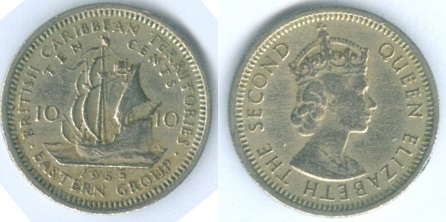 |
KM#5
/ Schön# 5
10
Cents. Year:
1955. Weight:
2.58g [2.60 g]. Metal:
Copper-Nickel.
Diameter:
17.50 mm.
Thickness: 1.35 mm.
Edge:
Reeded. Alignment:
Medal. Mint:
British Royal Mint, UK. |
|
Obverse:
"BRITISH CARIBBEAN TERRITORIES" written
at the top section. The "Golden Hind" (1577-1600s), ship of Sir
Francis Drake (1542-1596) in the sea in the center with Value "TEN CENTS" written above it. Numerals "10"
on left and right sides of the ship. Date "1955" written below the
ship. "·EASTERN GROUP·" written at the bottom
section.
Reverse:
Portrait of Queen
Elizabeth II facing right in the center.
"QUEEN ELIZABETH THE SECOND" written around
Queen Elizabeth II's
portrait.
Mintage:
5,000,000 + 2,000 Proofs.
Minted Years:
1955, 1956, 1959, 1961, 1962, 1964
and 1965. Engraver:
Thomas Humphrey Paget (Value
side) and Cecil
Walter Thomas (Queen Elizabeth II's
portrait side). |
|
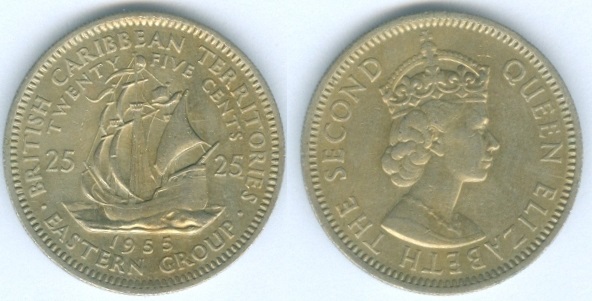 |
KM#6
/ Schön# 6
25
Cents. Year:
1955. Weight:
6.48g [6.50 g]. Metal:
Copper-Nickel.
Diameter:
23.50 mm.
Thickness: 1.90 mm.
Edge:
Reeded. Alignment:
Medal. Mint:
British Royal Mint, UK. |
|
Obverse:
"BRITISH CARIBBEAN TERRITORIES" written
at the top section. The "Golden Hind" (1577-1600s), ship of Sir
Francis Drake (1542-1596) in the sea in the center with Value
"TWENTY FIVE CENTS" written above it. Numerals "25"
on left and right sides of the ship. Date "1955" written below the
ship. "·EASTERN GROUP·" written at the bottom
section.
Reverse:
Portrait of Queen
Elizabeth II facing right in the center.
"QUEEN ELIZABETH THE SECOND" written around
Queen Elizabeth II's
portrait.
Mintage:
7,000,000 + 2,000 Proofs.
Minted Years:
1955, 1957, 1959, 1961, 1962, 1963, 1964
and 1965. Engraver:
Thomas Humphrey Paget (Value
side) and Cecil
Walter Thomas (Queen Elizabeth II's
portrait side). |
|
 |
|
KM#7
/ Schön# 7
50
Cents. Year:
1955. Weight:
12.94g [13.00 g]. Metal:
Copper-Nickel.
Diameter:
29.00 mm.
Thickness: 2.36 mm.
Edge:
Reeded. Alignment:
Medal. Mint:
British Royal Mint, UK.
Obverse:
"BRITISH CARIBBEAN TERRITORIES" written
in circular form almost around the edge. "EASTERN GROUP" written
Coats of Arms of the British Caribbean Territories in the center.
Value "FIFTY CENTS" divided between the lower part of the Coats of
Arms. Date "1955" divided between the lower part of the Coats
of Arms.
Lower part of Coats of Arms details:
- Shield of British Leeward Islands on the left.
- Top circle badge of Trinidad before the independence - boat
entering harbour with motto in three lines: "MISCERIQUE PROBAT
POPULOS ET FOEDERA JUNGI" (He approves of the mingling of the
peoples and their bonds of union).
- Bottom circle badge of British Guyana - ship with motto in
circular form: "DAMUS PETIMUSQUE VICISSIM" (We give and expect a
fair return).
- Shield of British Windward Islands on the right side.
Reverse:
Portrait of Queen
Elizabeth II facing right in the center.
"QUEEN ELIZABETH THE SECOND" written around
Queen Elizabeth II's
portrait.
Mintage:
1,500,000 + 2,000 Proofs.
Minted Years:
1955
and 1965. Engraver:
Thomas Humphrey Paget (Value
side) and Cecil
Walter Thomas (Queen Elizabeth II's
portrait side). |
|
| |
|
1956 |
| |
|
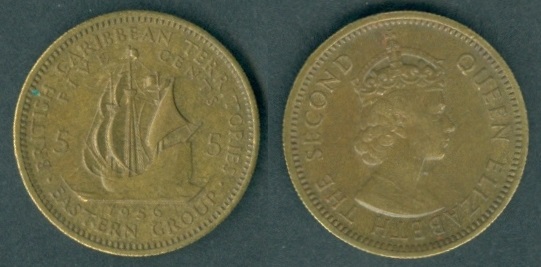 |
Same as above KM#4
Five Cents,
but...
Year: 1956.
Weight: 4.98 g
[5.00g]. Mint:
British Royal Mint, UK.
Mintage:
2,000,000 + N/A Proofs. |
|
 |
Same as above KM#5
Ten Cents,
but...
Year: 1956.
Weight: 2.58 g
[2.60g]. Mint:
British Royal Mint, UK.
Mintage:
4,000,000 + N/A Proofs. |
|
| |
|
1958 |
| |
|
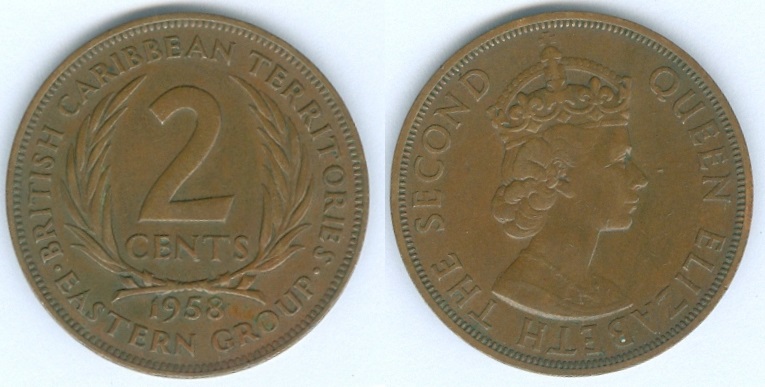 |
| Same as above KM#3
Two Cents,
but...
Year: 1958.
Weight: 9.61 g
[9.45g]. Mint:
British Royal Mint, UK.
Mintage:
1,250,000 + N/A Proofs. |
|
| |
|
1959 |
| |
|
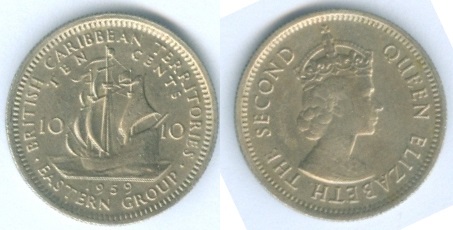 |
Same as above KM#5
Ten Cents,
but...
Year: 1959.
Weight: 2.67 g
[2.60g]. Mint:
British Royal Mint, UK.
Mintage:
2,000,000 + N/A Proofs. |
|
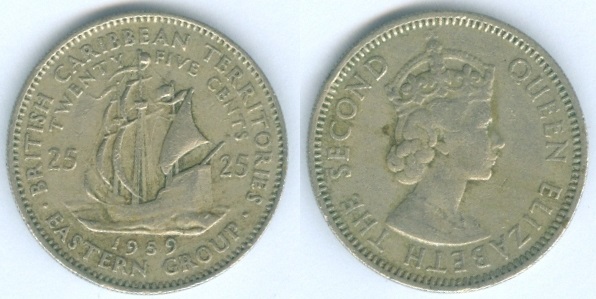 |
Same as above KM#6
Twenty Five Cents,
but...
Year: 1959.
Weight: 6.49 g
[6.50g]. Mint:
British Royal Mint, UK.
Mintage:
1,000,000 + N/A Proofs. |
|
| |
|
1960 |
| |
|
 |
KM#2
/ Schön# 2
Cent. Year:
1960. Weight:
5.73g [5.67 g]. Metal:
Bronze.
Diameter:
25.00 mm.
Thickness: 1.51 mm.
Edge:
Plain. Alignment:
Medal. Mint:
British Royal Mint, UK. |
|
Obverse:
"BRITISH CARIBBEAN TERRITORIES"
written at the top section. Large Numeral "1" in the center
with "CENT" written below it; flanked by palm tree fronds. Date
"1960" written below the palm tree fronds. "·EASTERN GROUP·" written
at the bottom section.
Reverse:
Portrait of Queen
Elizabeth II facing right in the center.
"QUEEN ELIZABETH THE SECOND" written around
Queen Elizabeth II's
portrait.
Mintage:
2,500,000 + N/A Proofs.
Minted Years:
1955, 1957, 1958, 1959, 1960, 1961, 1962, 1963, 1964
and 1965. Engraver:
Thomas Humphrey Paget (Value
side) and Cecil
Walter Thomas (Queen Elizabeth II's
portrait side). |
|
| |
|
1962 |
| |
|
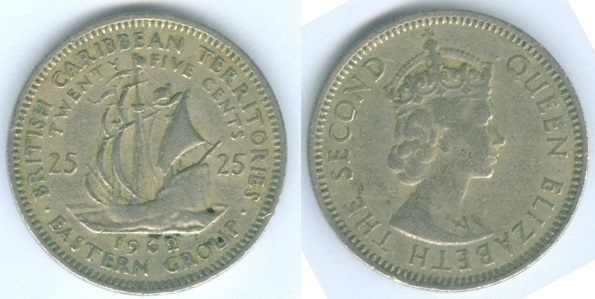 |
Same as above KM#6
Twenty Five Cents,
but...
Year: 1962.
Weight: 6.52 g
[6.50g]. Mint:
British Royal Mint, UK.
Mintage:
480,000 + N/A Proofs. |
|
| |
|
1964 |
| |
|
 |
Same as above KM#6
Twenty Five Cents,
but...
Year: 1964.
Weight: 6.36 g
[6.50g]. Mint:
British Royal Mint, UK.
Mintage:
480,000 + N/A Proofs. |
|
| |
|
1965 |
| |
|
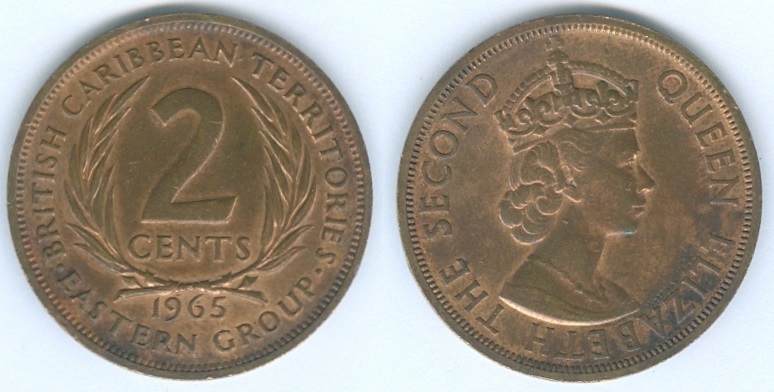 |
| Same as above KM#3
Two Cents,
but...
Year: 1965.
Weight: 9.45 g
[9.45g]. Mint:
British Royal Mint, UK.
Mintage:
2,001,000 + N/A Proof like + N/A Proofs. |
|
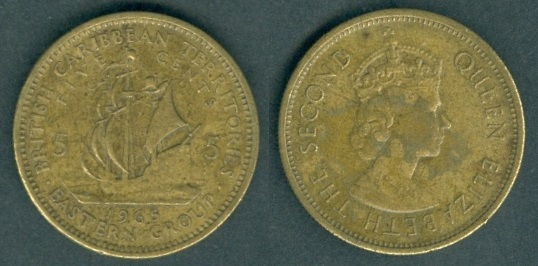 |
Same as above KM#4
Five Cents,
but...
Year: 1965.
Weight: 5.00 g
[5.00g]. Mint:
British Royal Mint, UK.
Mintage:
2,400,000 + N/A Proof like + N/A Proofs. |
|
 |
Same as above KM#5
Ten Cents,
but...
Year: 1965.
Weight: 2.64 g
[2.60g]. Mint:
British Royal Mint, UK.
Mintage:
3,200,000 + N/A Proof like + N/A Proofs. |
|
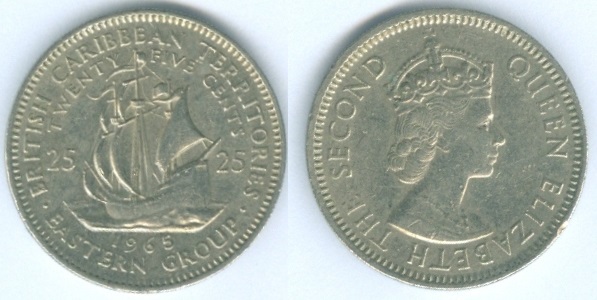 |
Same as above KM#6
Twenty Five Cents,
but...
Year: 1965.
Weight: 6.40 g
[6.50g]. Mint:
British Royal Mint, UK.
Mintage:
1,280,000 + N/A Proof like + N/A Proofs. |
|
| |
| |
| East
Caribbean Territories (1980-1981) |
| |
|
Currency: Eastern Caribbean Dollar = 100
cents [1965-date]. |
Two large designs of non-circulating
commemorative 10 Dollars were produced in 1980 and 1981.
- KM#8 10 Dollars 1980. Metal:
Copper-Nickel.
Weight: 28.28 g.
Diameter: 38.61 mm.
Subject: 10th
Anniversary of Caribbean Development Bank.
Mintage: N/A.
- KM#8a 10 Dollars 1980. Metal:
0.925 Silver. Weight:
28.28 g. Diameter:
38.61 mm. Subject:
10th Anniversary of Caribbean Development Bank.
Mintage: 10,000.
- KM#9 10 Dollars 1981. Metal:
Copper-Nickel.
Weight: 28.28 g.
Diameter: 38.61 mm.
Subject: Royal
Wedding. Mintage:
50,000.
- KM#9a 10 Dollars 1981. Metal:
0.925 Silver. Weight:
28.28 g. Diameter:
38.61 mm. Subject:
Royal Wedding.
Mintage: 30,000.
|
| |
| |
| East
Caribbean States (1981-date) |
| |
| Currency:
Eastern Caribbean Dollar = 100 cents [1965-date]. |
| East Caribbean Dollar has been pegged to the
United States dollar since 07 July 1976, at the exchange rate of US$ 1 = EC$
2.70. |
| Between 1965 and 1983,
the Eastern Caribbean Currency Authority issued the EC$, with banknotes from
1965 and coins from 1981. The EC$ is now issued by the Eastern Caribbean
Central Bank, based in the city of Basseterre, in Saint Kitts and Nevis. The
bank was established by an agreement (the Eastern Caribbean Central Bank
Agreement) signed at Port of Spain on 05 July 1983. The exchange rate of
$4.80 = £1 sterling (equivalent to the old $1 = 4s 2d)
continued until 1976 for the new Eastern Caribbean dollar. |
| Until 1981, the coins of
the BWI$ circulated. In 1981, a new series of coins was introduced in
denominations of 1, 2, 5, 10 and 25 cents and 1 dollar. The 1- and 5-cent
coins were scalloped in shape while the 2-cent coin was square. These three
were struck in aluminum. The 10- and 25-cent coins were round and cupro-nickel.
The dollar was aluminum bronze and also round. The round, aluminum bronze
dollar coin was replaced in 1989 with a decagonal, cupro-nickel type. In
2002 new and larger round-shaped 1, 2, and 5 cent pieces were introduced,
along with a new 1 dollar coin which was also round. The effigy of Queen
Elizabeth II was also changed that same year on all coin denominations to
the Ian Rank-Broadley design, making it the last commonwealth currency up to
that date to discontinue the Arnold Machin portrait. Their compositions
remained aluminum and cupro-nickel, respectively. Higher denominations
exist, but these were issued only as medal-coins. 1 cent and 2 cents coins
were withdrawn from circulation in July 2015, but will remain legal tender
until 30 June 2020. |
| |
|
1981 |
| |
|
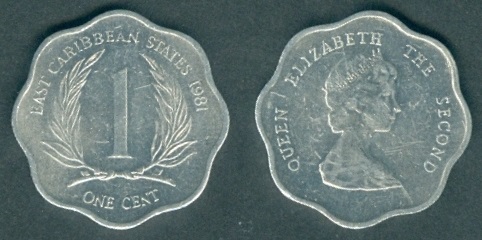 |
KM#10
/ Schön# 10
Cent. Year:
1981. Weight:
0.80g [0.80 g]. Metal:
Aluminium.
Diameter:
18.00 mm; 8-sided. Edge:
Plain. Alignment:
Medal. Mint:
British Royal Mint, UK. |
|
Obverse:
"EAST CARIBBEAN STATES 1981"
written at the top section. Numeral "1" flanked by palm tree fronds.
Value "ONE CENT" written at the bottom.
Reverse:
Portrait of Queen
Elizabeth II facing right in the center.
"QUEEN ELIZABETH THE SECOND" written in the top section around
Queen Elizabeth II's
portrait.
Mintage:
N/A + 5,000 Proofs.
Minted Years:
1981,
1983, 1984, 1986, 1987, 1989, 1991, 1992, 1993, 1994, 1995, 1996,
1997, 1998, 1999, 2000 and 2001.
Engraver:
Thomas Humphrey Paget (Value
side) and Arnold
Machin (Queen Elizabeth II's
portrait side).
Arnold Machin O.B.E., R.A.
(30 September 1911 – 09 March 1999) was a British artist, sculptor,
and coin and postage stamp designer.
In 1964 Machin was chosen to design a new effigy of the Queen for
the decimal coinage, which was to be introduced from 1968. This was
used for all British coins until 1984 and was also used on the coins
of Rhodesia in 1964, coins of Canada from 1965 to 1989, Australia
from 1966 to 1984 and New Zealand from 1967 to 1985.
In 1966 the Queen approved Machin's similar design for an effigy of
her to be used on what came to be known as the "Machin series" of
British definitive postage stamps. Machin produced a bas-relief in
clay which, when combined with a different coloured background, is
reminiscent of the overlaid decoration of potteries such as
Wedgwood. The design was first used on the 4d stamp which was issued
in June 1967, and has been used on all British definitive stamps
(except more recent regional issues) since. It is thought that this
design is one of the most reproduced works of art in history with,
to date, approximately 320 billion copies produced.
On several occasions the Queen has been approached with suggestions
for the replacement of the Machin stamp portrait. Although she has
considered alternatives, she has never approved any new design,
stipulating that any such replacement would have to be "a work of
real quality".
In 2007 the Machin-designed stamp was still in use at its 40th
anniversary and to mark the occasion, the Post Office issued a
commemorative stamp featuring a photograph of Machin. It was also
available for sale in a miniature sheet which incorporated another
stamp with a reproduction of a Machin series stamp, as well as two
£1 Machins in different colours.
Machin and his wife had a son, Francis (1949–2007), who was also an
artist, and an architect. After Francis died, some of his father's
possessions, from his house near Eccleshall in rural Staffordshire,
were sold at auction. These included the fourth of the known final
plasters made to create the Machin stamp series, the three others
being kept in the Royal Mail archives.
A Minor planet "3109 Machin" is named in his honour, which was
discovered by Luboš Kohoutek (a Czech astronomer and a discoverer of
minor planets and comets) from Hamburg-Bergedorf Observatory on 19
February 1974. |
|
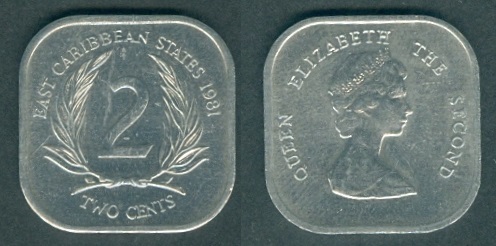 |
KM#11
/ Schön# 11
2
Cents. Year:
1981. Weight:
0.99g [1.00 g]. Metal:
Aluminium.
Diameter:
18.00 mm x 18.00 mm; Square. Edge:
Plain. Alignment:
Medal. Mint:
British Royal Mint, UK. |
|
Obverse:
"EAST CARIBBEAN STATES 1981"
written at the top section. Numeral "2" flanked by palm tree
fronds. Value "TWO CENTS" written at the bottom.
Reverse:
Portrait of Queen
Elizabeth II facing right in the center.
"QUEEN ELIZABETH THE SECOND" written in the top section around
Queen Elizabeth II's
portrait.
Mintage:
N/A + 5,000 Proofs.
Minted Years:
1981,
1984, 1986, 1987, 1989, 1991, 1992, 1993, 1994, 1995, 1996,
1997, 1998, 1999 and 2000.
Engraver:
Thomas Humphrey Paget (Value
side) and Arnold
Machin (Queen Elizabeth II's
portrait side).
|
|
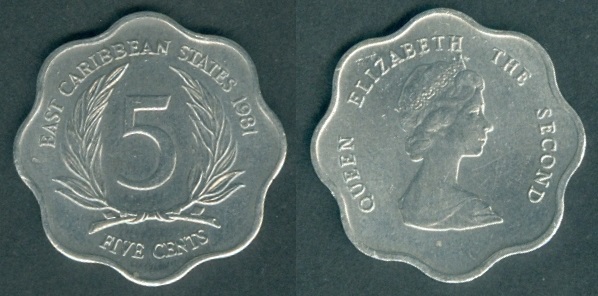 |
KM#12
/ Schön# 12
5
Cents. Year:
1981. Weight:
1.29g [1.31 g]. Metal:
Aluminium.
Diameter:
23.00 mm; 8-sided. Edge:
Plain. Alignment:
Medal. Mint:
British Royal Mint, UK. |
|
Obverse:
"EAST CARIBBEAN STATES 1981"
written at the top section. Numeral "5" flanked by palm tree
fronds. Value "FIVE CENTS" written at the bottom.
Reverse:
Portrait of Queen
Elizabeth II facing right in the center.
"QUEEN ELIZABETH THE SECOND" written in the top section around
Queen Elizabeth II's
portrait.
Mintage:
N/A + 5,000 Proofs.
Minted Years:
1981,
1984, 1986, 1987, 1989, 1991, 1992, 1993, 1994, 1995, 1996,
1997, 1998, 1999 and 2000. Engraver:
Thomas Humphrey Paget (Value
side) and Arnold
Machin (Queen Elizabeth II's
portrait side).
|
|
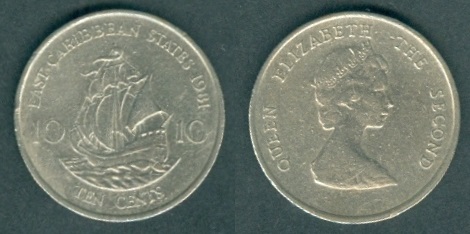 |
KM#13
/ Schön# 13
10
Cents. Year:
1981. Weight:
2.61g [2.59 g]. Metal:
Copper-Nickel.
Diameter:
17.50 mm. Edge:
Reeded. Alignment:
Medal. Mint:
British Royal Mint, UK. |
|
Obverse:
"EAST CARIBBEAN STATES 1981"
written at the top section. The "Golden Hind" (1577-1600s), ship of
Sir Francis Drake (1542-1596) in the sea in the center. Numerals "10"
on left and right sides of the ship. Value "TEN CENTS" written at the bottom.
Reverse:
Portrait of Queen
Elizabeth II facing right in the center.
"QUEEN ELIZABETH THE SECOND" written in the top section around
Queen Elizabeth II's
portrait.
Mintage:
N/A + 5,000 Proofs.
Minted Years:
1981,
1986, 1987, 1989, 1991, 1992, 1993, 1994, 1995, 1996,
1997, 1998, 1999 and 2000. Engraver:
Thomas Humphrey Paget (Value
side) and Arnold
Machin (Queen Elizabeth II's
portrait side).
Golden Hind was an English
galleon best known for her privateering circumnavigation of the
globe between 1577 and 1580, captained by Sir Francis Drake. She was
originally known as Pelican, but was renamed by Drake mid-voyage in
1578, in honour of his patron, Sir Christopher Hatton, whose crest
was a golden 'hind' (a female red deer). Hatton was one of the
principal sponsors of Drake's world voyage. A full-sized, still
sailable reconstruction exists in London, on the south bank of the
Thames. Fate: Golden Hind was disintegrated and broken
up in late 1600s; two replicas exist.
Sir Francis Drake (b. c.1540 – d. 28 January 1596) was an
English sea captain, privateer, slave trader, pirate, naval officer
and explorer of the Elizabethan era. Drake carried out the second
circumnavigation of the world in a single expedition, from 1577 to
1580, and was the first to complete the voyage as captain while
leading the expedition throughout the entire circumnavigation. With
his incursion into the Pacific Ocean, he claimed what is now
California for the English and inaugurated an era of conflict with
the Spanish on the western coast of the Americas, an area that had
previously been largely unexplored by western shipping. Queen
Elizabeth I awarded Drake a knighthood on 04 April 1581, which he
received on the Golden Hind in Deptford. In the same year he was
appointed mayor of Plymouth. As a Vice Admiral, he was
second-in-command of the English fleet in the victorious battle
against the Spanish Armada in 1588. He died of dysentery in January
1596, after unsuccessfully attacking San Juan, Puerto Rico. Drake's
exploits made him a hero to the English, but his privateering led
the Spanish to brand him a pirate, known to them as El Draque. King
Philip II allegedly offered a reward for his capture or death of
20,000 ducats, about £6 million (US$8 million) in modern currency.
On 26 September 1580, Golden Hind sailed into Plymouth with Drake
and 59 remaining crew aboard, along with a rich cargo of spices and
captured Spanish treasures. The Queen's half-share of the cargo
surpassed the rest of the crown's income for that entire year. Drake
was hailed as the first Englishman to circumnavigate the Earth (and
the second such voyage arriving with at least one ship intact, after
Elcano's in 1520).
After returning from his voyage of circumnavigation, Drake became
the Mayor of Plymouth, in September 1581. He became a member of
parliament during a session of the 4th Parliament of Elizabeth I, on
16 January 1581, for the constituency of Camelford. He did not
actively participate at this point, and on 17 February 1581 he was
granted leave of absence "for certain his necessary business in the
service of her Majesty".
Drake became a member of parliament again in 1584 for Bossiney on
the forming of the 5th Parliament of Elizabeth I. He served the
duration of the parliament and was active in issues regarding the
navy, fishing, early American colonisation, and issues related
chiefly to Devon. He spent the time covered by the next two
parliamentary terms engaged in other duties and an expedition to
Portugal. He became a member of parliament for Plymouth in 1593. He
was active in issues of interest to Plymouth as a whole, but also to
emphasise defence against the Spanish.
Drake's seafaring career continued into his mid-fifties. In 1595, he
failed to conquer the port of Las Palmas, and following a disastrous
campaign against Spanish America, where he suffered a number of
defeats, he unsuccessfully attacked San Juan de Puerto Rico,
eventually losing the Battle of San Juan. The Spanish gunners from
El Morro Castle shot a cannonball through the cabin of Drake's
flagship, but he survived. He attempted to attack over land in an
effort to capture the rich port of Panamá but was defeated again. A
few weeks later, in January 1596, he died (aged about 56) of
dysentery, a common disease in the tropics at the time, while
anchored off the coast of Portobelo where some Spanish treasure
ships had sought shelter. Following his death, the English fleet
withdrew.
Before dying, he asked to be dressed in his full armour. He was
buried at sea in a sealed lead-lined coffin, near Portobelo, a few
miles off the coastline. It is supposed that his final resting place
is near the wrecks of two British ships, the Elizabeth and the
Delight, scuttled in Portobelo Bay. Divers continue to search for
the coffin. Drake's body has never been recovered. |
|
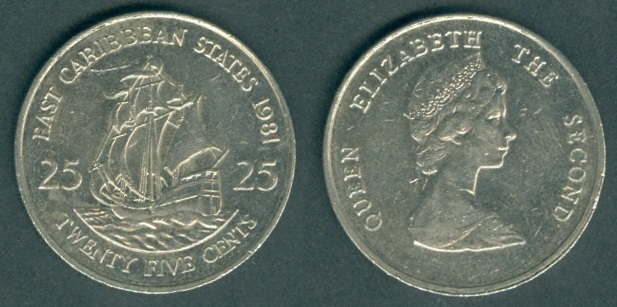 |
KM#14
/ Schön# 14
25
Cents. Year:
1981. Weight:
6.39g [6.48 g]. Metal:
Copper-Nickel.
Diameter:
23.00 mm. Edge:
Reeded. Alignment:
Medal. Mint:
British Royal Mint, UK. |
|
Obverse:
"EAST CARIBBEAN STATES 1981"
written at the top section. The "Golden Hind" (1577-1600s), ship of
Sir Francis Drake (1542-1596) in the sea in the center. Numerals "25"
on left and right sides of the ship. Value "TWENTY FIVE CENTS" written at the bottom.
Reverse:
Portrait of Queen
Elizabeth II facing right in the center.
"QUEEN ELIZABETH THE SECOND" written in the top section around
Queen Elizabeth II's
portrait.
Mintage:
N/A + 5,000 Proofs.
Minted Years:
1981,
1986, 1987, 1989, 1991, 1992, 1993, 1994, 1995, 1996,
1997, 1998, 1999 and 2000. Engraver:
Thomas Humphrey Paget (Value
side) and Arnold
Machin (Queen Elizabeth II's
portrait side). |
|
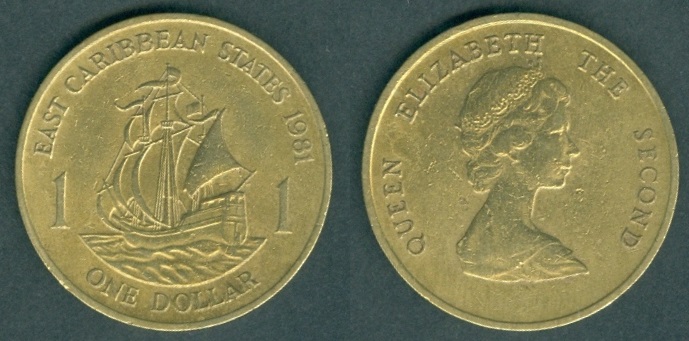 |
|
KM#15
/ Schön# 15
One Dollar. Year:
1981. Weight:
7.84g [8.00 g]. Metal:
Aluminium-Bronze.
Diameter:
26.50 mm.
Thickness:
2.00 mm. Edge:
Reeded. Alignment:
Medal. Mint:
British Royal Mint, UK.
Obverse:
"EAST CARIBBEAN STATES 1981"
written at the top section. The "Golden Hind" (1577-1600s), ship of
Sir Francis Drake (1542-1596) in the sea in the center. Numeral "1"
on left and right sides of the ship. Value "ONE DOLLAR" written at the bottom.
Reverse:
Portrait of Queen
Elizabeth II facing right in the center.
"QUEEN ELIZABETH THE SECOND" written in the top section around
Queen Elizabeth II's
portrait.
Mintage:
N/A + 5,000 Proofs.
Minted Years:
1981 and
1986. Engraver:
Thomas Humphrey Paget (Value
side) and Arnold
Machin (Queen Elizabeth II's
portrait side). |
|
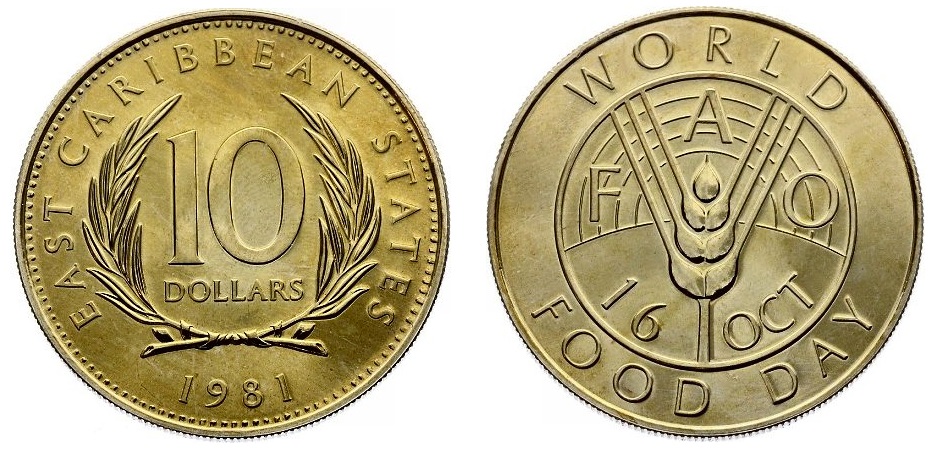 |
|
KM#16
/ Schön# 17
10 Dollars. Year:
1981. Weight:
28.38g [28.00 g]. Metal:
Copper-Nickel.
Diameter:
40.00 mm.
Thickness:
3.00 mm. Edge:
Reeded. Alignment:
Medal. Mint:
British Royal Mint, UK.
Obverse:
"EAST CARIBBEAN STATES"
written at the top section. Numerals "10" with "DOLLARS"
written below it; flanked by palm tree fronds.
Date "1981" written at the bottom.
Reverse:
FAO - World Food Day logo in the center.
Mintage:
12,000 (estimated).
Minted Years:
One year type.
Subject:
FAO (Food &
Agriculture Organisation) -
World Food Day on 16 October 1981.
This is non-circulating commemorative coin.
Note:
KM#16a were produced in 0.925 silver
with same specifications. Mintage: 5,000 (estimated). |
|
| |
|
1984 |
| |
|
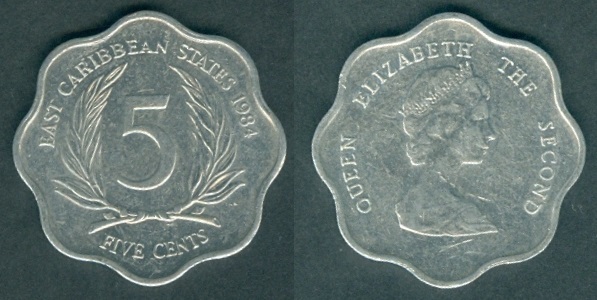 |
Same as above KM#12
Five Cents,
but...
Year: 1984.
Weight: 1.33 g
[1.31g]. Mint:
British Royal Mint, UK.
Mintage:
N/A. |
|
| |
|
1986 |
| |
|
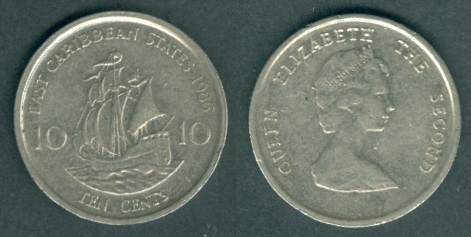 |
Same as above KM#13
Ten Cents,
but...
Year: 1986.
Weight: 2.59 g
[2.59g]. Mint:
British Royal Mint, UK.
Mintage:
N/A. |
|
| |
|
1987 |
| |
|
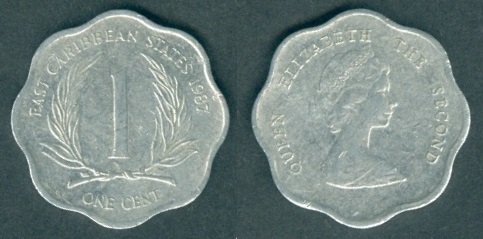 |
Same as above KM#10 One Cent,
but...
Year: 1987.
Weight: 0.81 g
[0.80g]. Mint:
British Royal Mint, UK.
Mintage:
N/A. |
|
 |
Same as above KM#13 Ten Cents,
but...
Year: 1987.
Weight: 2.54 g
[2.59g]. Mint:
British Royal Mint, UK.
Mintage:
N/A. |
|
| |
|
1989 |
| |
|
 |
Same as above KM#10
One Cent,
but...
Year: 1989.
Weight: 0.81 g
[0.80g]. Mint:
British Royal Mint, UK.
Mintage:
N/A. |
|
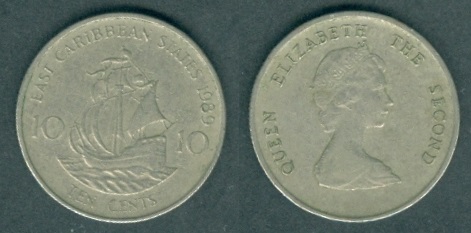 |
Same as above KM#13
Ten Cents,
but...
Year: 1989.
Weight: 2.52 g
[2.59g]. Mint:
British Royal Mint, UK.
Mintage:
N/A. |
|
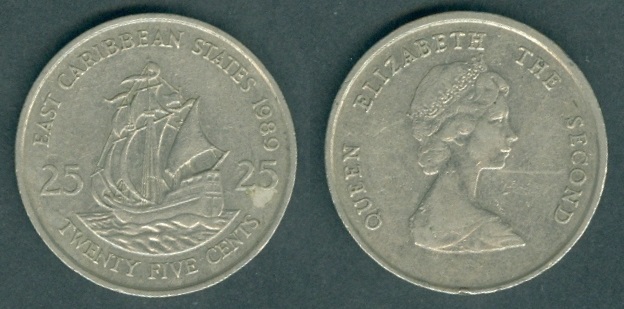 |
Same as above KM#14
Twenty Five Cents,
but...
Year: 1989.
Weight: 6.49 g
[6.48g]. Mint:
British Royal Mint, UK.
Mintage:
N/A. |
|
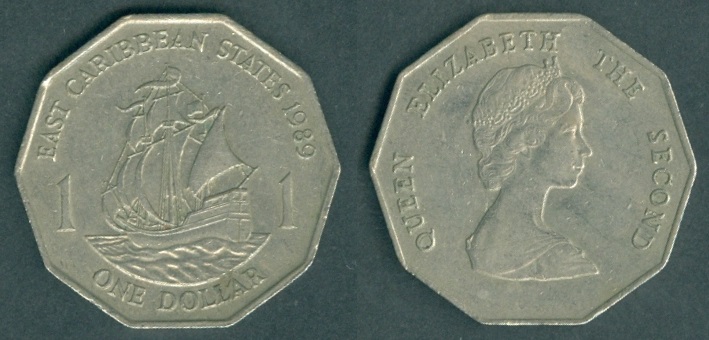 |
|
KM#20
/ Schön# 16
One Dollar. Year:
1989. Weight:
8.05g [8.00 g]. Metal:
Copper-Nickel.
Diameter:
27.00 mm; Decagonal (10-sided).
Thickness:
1.70 mm. Edge:
Reeded / Plain; 5 patches each (19 dents in
each Reeded patch). Alignment:
Medal. Mint:
British Royal Mint, UK.
Obverse:
"EAST CARIBBEAN STATES 1989"
written at the top section. The "Golden Hind" (1577-1600s), ship of
Sir Francis Drake (1542-1596) in the sea in the center. Numeral "1"
on left and right sides of the ship. Value "ONE DOLLAR" written at the bottom.
Reverse:
Portrait of Queen
Elizabeth II facing right in the center.
"QUEEN ELIZABETH THE SECOND" written in the top section around
Queen Elizabeth II's
portrait.
Mintage:
N/A.
Minted Years:
1989,
1991, 1992, 1993, 1994, 1995, 1996, 1997, 1998, 1999 and 2000. Engraver:
Thomas Humphrey Paget (Value
side) and Arnold
Machin (Queen Elizabeth II's
portrait side). |
|
| |
|
1991 |
| |
|
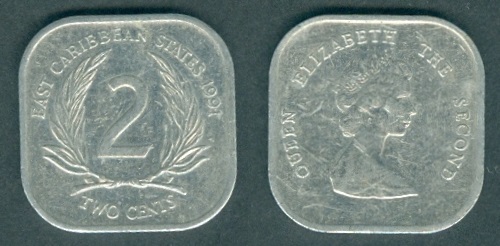 |
Same as above KM#11
Two Cents,
but...
Year: 1991.
Weight: 1.01 g
[1.00g]. Mint:
British Royal Mint, UK.
Mintage:
N/A. |
|
 |
Same as above KM#12
Five Cents,
but...
Year: 1991.
Weight: 1.32 g
[1.31g]. Mint:
British Royal Mint, UK.
Mintage:
N/A. |
|
 |
| Same as above KM#20
One Dollar,
but...
Year: 1991.
Weight: 8.00 g
[8.00g]. Mint:
British Royal Mint, UK.
Mintage:
N/A. |
|
| |
|
1992 |
| |
|
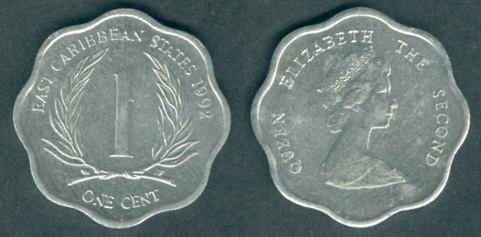 |
Same as above KM#10
One Cent,
but...
Year: 1992.
Weight: 0.81 g
[0.80g]. Mint:
British Royal Mint, UK.
Mintage:
N/A. |
|
| |
|
1993 |
| |
|
 |
Same as above KM#10
One Cent,
but...
Year: 1993.
Weight: 0.82 g
[0.80g]. Mint:
British Royal Mint, UK.
Mintage:
N/A. |
|
| |
|
1994 |
| |
|
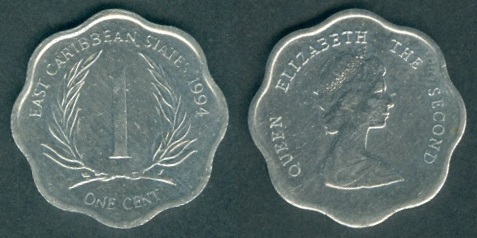 |
Same as above KM#10
One Cent,
but...
Year: 1994.
Weight: 0.81 g
[0.80g]. Mint:
British Royal Mint, UK.
Mintage:
N/A. |
|
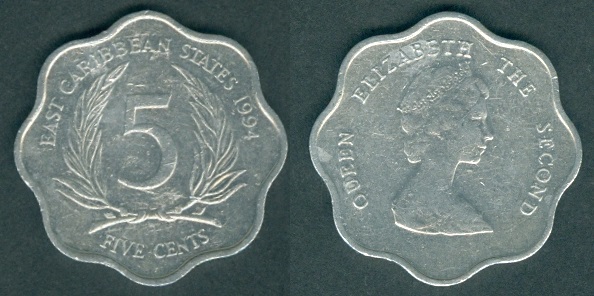 |
Same as above KM#12
Five Cents,
but...
Year: 1994.
Weight: 1.31 g
[1.31g]. Mint:
British Royal Mint, UK.
Mintage:
N/A. |
|
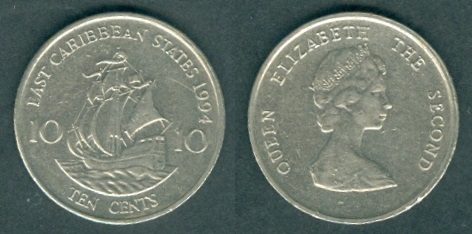 |
Same as above KM#13
Ten Cents,
but...
Year: 1994.
Weight: 2.59 g
[2.59g]. Mint:
British Royal Mint, UK.
Mintage:
N/A. |
|
| |
|
1995 |
| |
|
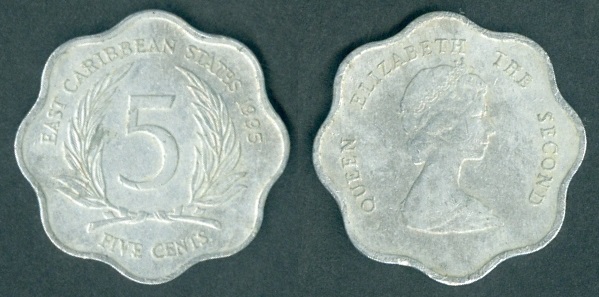 |
Same as above KM#12
Five Cents,
but...
Year: 1995.
Weight: 1.30 g
[1.31g]. Mint:
British Royal Mint, UK.
Mintage:
N/A. |
|
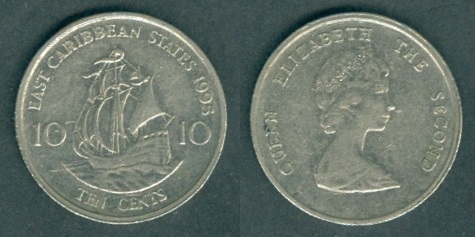 |
Same as above KM#13
Ten Cents,
but...
Year: 1995.
Weight: 2.62 g
[2.59g]. Mint:
British Royal Mint, UK.
Mintage:
N/A. |
|
| |
|
1997 |
| |
|
 |
Same as above KM#10
One Cent,
but...
Year: 1997.
Weight: 0.83 g
[0.80g]. Mint:
British Royal Mint, UK.
Mintage:
N/A. |
|
 |
Same as above KM#11
Two Cents,
but...
Year: 1997.
Weight: 1.03 g
[1.00g]. Mint:
British Royal Mint, UK.
Mintage:
N/A. |
|
 |
Same as above KM#12
Five Cents,
but...
Year: 1997.
Weight: 1.33 g
[1.31g]. Mint:
British Royal Mint, UK.
Mintage:
N/A. |
|
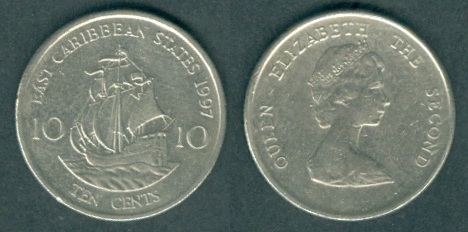 |
Same as above KM#13
Ten Cents,
but...
Year: 1997.
Weight: 2.55 g
[2.59g]. Mint:
British Royal Mint, UK.
Mintage:
N/A. |
|
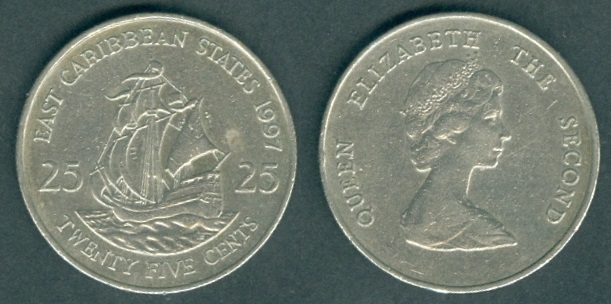 |
Same as above KM#14
Twenty Five Cents,
but...
Year: 1997.
Weight: 6.41 g
[6.48g]. Mint:
British Royal Mint, UK.
Mintage:
N/A. |
|
 |
| Same as above KM#20
One Dollar,
but...
Year: 1997.
Weight: 8.00 g
[8.00g]. Mint:
British Royal Mint, UK.
Mintage:
N/A. |
|
| |
|
1998 |
| |
|
 |
Same as above KM#12
Five Cents,
but...
Year: 1998.
Weight: 1.36 g
[1.31g]. Mint:
British Royal Mint, UK.
Mintage:
N/A. |
|
| |
|
1999 |
| |
|
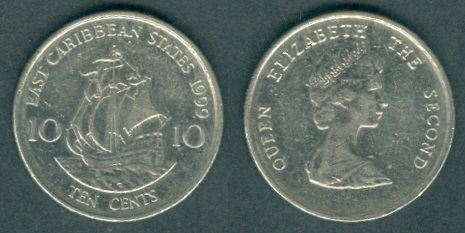 |
Same as above KM#13
Ten Cents,
but...
Year: 1999.
Weight: 2.60 g
[2.59g]. Mint:
British Royal Mint, UK.
Mintage:
N/A. |
|
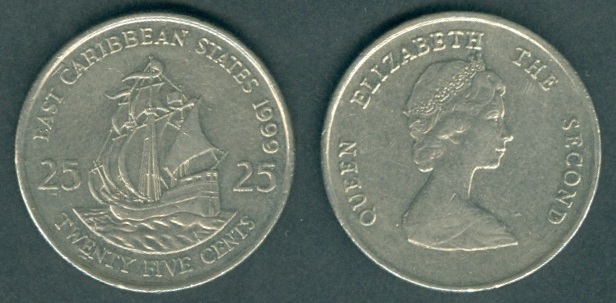 |
Same as above KM#14
Twenty Five Cents,
but...
Year: 1999.
Weight: 6.55 g
[6.48g]. Mint:
British Royal Mint, UK.
Mintage:
N/A. |
|
| |
| 2000 |
| |
|
 |
Same as above KM#10
One Cent,
but...
Year: 2000.
Weight: 0.80 g
[0.80g]. Mint:
British Royal Mint, UK.
Mintage:
N/A. |
|
 |
Same as above KM#12
Five Cents,
but...
Year: 2000.
Weight: 1.34 g
[1.31g]. Mint:
British Royal Mint, UK.
Mintage:
N/A. |
|
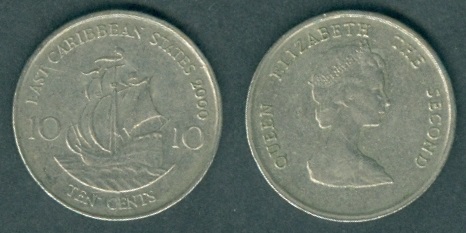 |
Same as above KM#13
Ten Cents,
but...
Year: 2000.
Weight: 2.62 g
[2.59g]. Mint:
British Royal Mint, UK.
Mintage:
N/A. |
|
 |
Same as above KM#14
Twenty Five Cents,
but...
Year: 2000.
Weight: 6.46 g
[6.48g]. Mint:
British Royal Mint, UK.
Mintage:
N/A. |
|
| |
| 2002 |
| |
|
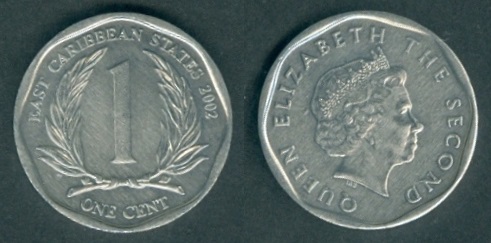 |
KM#34
/ Schön# 35
Cent. Year:
2002. Weight:
1.03g [1.03 g]. Metal:
Aluminium.
Diameter:
18.00 mm. Edge:
Plain. Alignment:
Medal. Mint:
British Royal Mint, UK. |
|
Obverse:
"EAST CARIBBEAN STATES 2002"
written at the top section. Numeral "1" flanked by palm tree fronds.
Value "ONE CENT" written at the bottom.
Reverse:
Portrait of Queen
Elizabeth II facing right in the center.
"QUEEN ELIZABETH THE SECOND" written around
Queen Elizabeth II's
portrait.
Mintage:
N/A.
Minted Years:
2002,
2004, 2008, 2011 and 2013. Engraver:
Thomas Humphrey Paget (Value
side) and Ian
Rank-Broadley (Queen Elizabeth II's
portrait side).
|
|
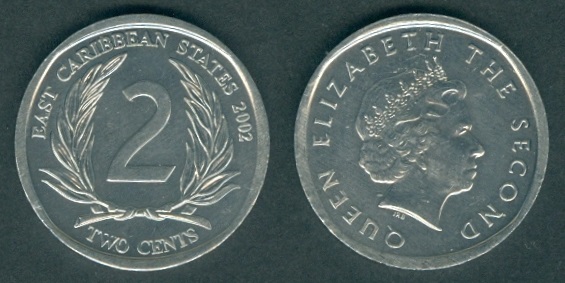 |
KM#35
/ Schön# 36
2
Cents. Year:
2002. Weight:
1.45g [1.42 g]. Metal:
Aluminium.
Diameter:
21.50 mm. Edge:
Plain. Alignment:
Medal. Mint:
British Royal Mint, UK. |
|
Obverse:
"EAST CARIBBEAN STATES 2002"
written at the top section. Numeral "2" flanked by palm tree
fronds. Value "TWO CENTS" written at the bottom.
Reverse:
Portrait of Queen
Elizabeth II facing right in the center.
"QUEEN ELIZABETH THE SECOND" written around
Queen Elizabeth II's
portrait.
Mintage:
N/A.
Minted Years:
2002, 2004, 2008 and 2011. Engraver:
Thomas Humphrey Paget (Value
side) and Ian
Rank-Broadley (Queen Elizabeth II's
portrait side). |
|
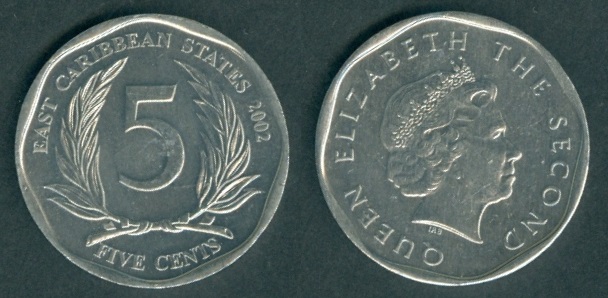 |
KM#36
/ Schön# 37
5
Cents. Year:
2002. Weight:
1.81g [1.75 g]. Metal:
Aluminium.
Diameter:
23.00 mm. Edge:
Plain. Alignment:
Medal. Mint:
British Royal Mint, UK. |
|
Obverse:
"EAST CARIBBEAN STATES 2002"
written at the top section. Numeral "5" flanked by palm tree
fronds. Value "FIVE CENTS" written at the bottom.
Reverse:
Portrait of Queen
Elizabeth II facing right in the center.
"QUEEN ELIZABETH THE SECOND" written around
Queen Elizabeth II's
portrait.
Mintage:
N/A.
Minted Years:
2002, 2004, 2008, 2010, 2015 and 2019. Engraver:
Thomas Humphrey Paget (Value
side) and Ian
Rank-Broadley (Queen Elizabeth II's
portrait side). |
|
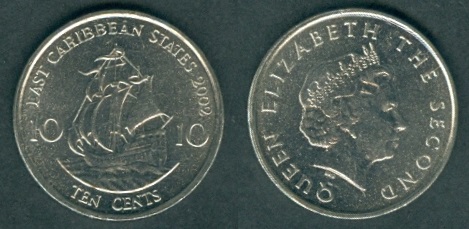 |
KM#37
/ Schön# 36
10
Cents. Year:
2002. Weight:
2.58g [2.59 g]. Metal:
Copper-Nickel.
Diameter:
17.50 mm. Edge:
Reeded. Alignment:
Medal. Mint:
British Royal Mint, UK. |
|
Obverse:
"EAST CARIBBEAN STATES 2002"
written at the top section. The "Golden Hind" (1577-1600s), ship of
Sir Francis Drake (1542-1596) in the sea in the center. Numerals "10"
on left and right sides of the ship. Value "TEN CENTS" written at the bottom.
Reverse:
Portrait of Queen
Elizabeth II facing right in the center.
"QUEEN ELIZABETH THE SECOND" written around
Queen Elizabeth II's
portrait.
Mintage:
N/A.
Minted Years:
2002,
2004 and 2007. Engraver:
Thomas Humphrey Paget (Value
side) and Ian
Rank-Broadley (Queen Elizabeth II's
portrait side). |
|
 |
KM#38
/ Schön# 39
25
Cents. Year:
2002. Weight:
6.45g [6.48 g]. Metal:
Copper-Nickel.
Diameter:
23.00 mm. Edge:
Reeded. Alignment:
Medal. Mint:
British Royal Mint, UK. |
|
Obverse:
"EAST CARIBBEAN STATES 2002"
written at the top section. The "Golden Hind" (1577-1600s), ship of
Sir Francis Drake (1542-1596) in the sea in the center. Numerals "25"
on left and right sides of the ship. Value "TWENTY FIVE CENTS" written at the bottom.
Reverse:
Portrait of Queen
Elizabeth II facing right in the center.
"QUEEN ELIZABETH THE SECOND" written around
Queen Elizabeth II's
portrait.
Mintage:
N/A + 5,000 Proofs.
Minted Years:
2002,
2004 and 2007. Engraver:
Thomas Humphrey Paget (Value
side) and Ian
Rank-Broadley (Queen Elizabeth II's
portrait side). |
|
 |
|
KM#39
/ Schön# 40
One Dollar. Year:
2002. Weight:
7.95g [7.98 g]. Metal:
Copper-Nickel.
Diameter:
26.00 mm.
Thickness:
1.92 mm. Edge:
Reeded / Plain; 4 patches each. Alignment:
Medal. Mint:
British Royal Mint, UK.
Obverse:
"EAST CARIBBEAN STATES 2002"
written at the top section. The "Golden Hind" (1577-1600s), ship of
Sir Francis Drake (1542-1596) in the sea in the center. Numeral "1"
on left and right sides of the ship. Value "ONE DOLLAR" written at the bottom.
Reverse:
Portrait of Queen
Elizabeth II facing right in the center.
"QUEEN ELIZABETH THE SECOND" written around
Queen Elizabeth II's
portrait.
Mintage:
N/A.
Minted Years: 2002,
2004 and 2007. Engraver:
Thomas Humphrey Paget (Value
side) and Ian
Rank-Broadley (Queen Elizabeth II's
portrait side). |
|
| |
| 2004 |
| |
|
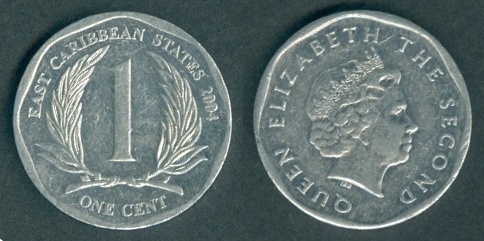 |
Same as above KM#34
One Cent,
but...
Year: 2004.
Weight: 1.02 g
[1.03g]. Mint:
British Royal Mint, UK.
Mintage:
N/A. |
|
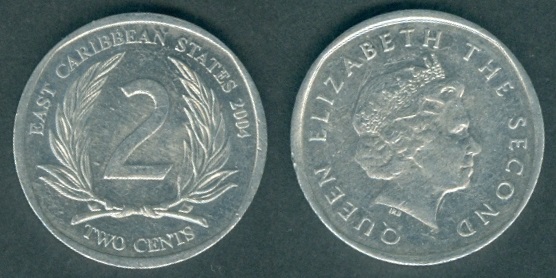 |
Same as above KM#35
Two Cents,
but...
Year: 2004.
Weight: 1.42 g
[1.42g]. Mint:
British Royal Mint, UK.
Mintage:
N/A. |
|
 |
Same as above KM#36
Five Cents,
but...
Year: 2004.
Weight: 1.76 g
[1.75g]. Mint:
British Royal Mint, UK.
Mintage:
N/A. |
|
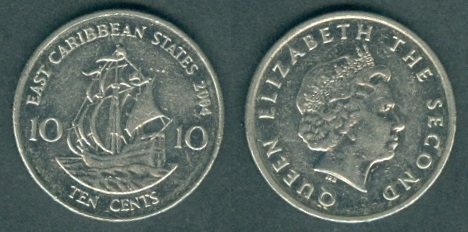 |
Same as above KM#37
Ten Cents,
but...
Year: 2004.
Weight: 2.60 g
[2.59g]. Mint:
British Royal Mint, UK.
Mintage:
N/A. |
|
 |
Same as above KM#38
Twenty Five Cents,
but...
Year: 2004.
Weight: 6.51 g
[6.48g]. Mint:
British Royal Mint, UK.
Mintage:
N/A. |
|
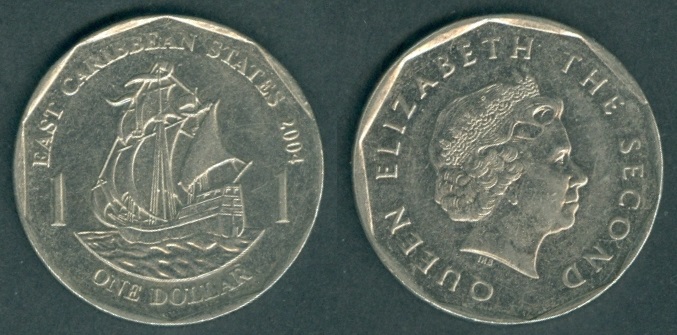 |
| Same as above KM#39
One Dollar,
but...
Year: 2004.
Weight: 7.96 g
[7.98g]. Mint:
British Royal Mint, UK.
Mintage:
N/A. |
|
| |
| 2007 |
| |
|
 |
Same as above KM#37
Ten Cents,
but...
Year: 2007.
Weight: 2.55 g
[2.59g]. Mint:
British Royal Mint, UK.
Mintage:
N/A. |
|
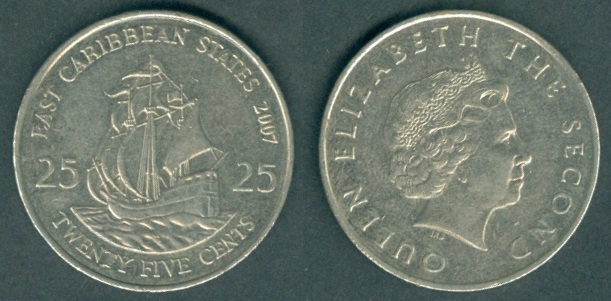 |
Same as above KM#38
Twenty Five Cents,
but...
Year: 2007.
Weight: 6.39 g
[6.48g]. Mint:
British Royal Mint, UK.
Mintage:
N/A. |
|
| |
| 2008 |
| |
|
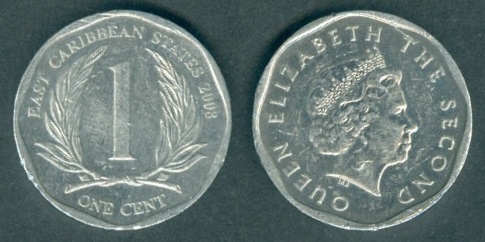 |
Same as above KM#34
One Cent,
but...
Year: 2008.
Weight: 1.02 g
[1.03g]. Mint:
British Royal Mint, UK.
Mintage:
N/A. |
|
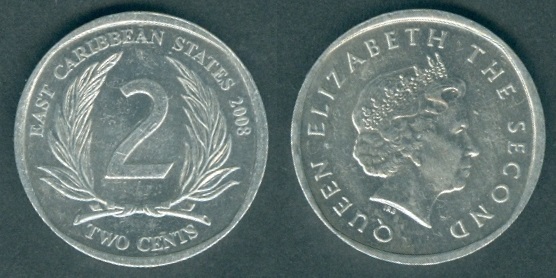 |
Same as above KM#35
Two Cents,
but...
Year: 2008.
Weight: 1.42 g
[1.42g]. Mint:
British Royal Mint, UK.
Mintage:
N/A. |
|
 |
Same as above KM#36
Five Cents,
but...
Year: 2008.
Weight: 1.76 g
[1.75g]. Mint:
British Royal Mint, UK.
Mintage:
N/A. |
|
-25thAnniversaryCentralBank.jpg) |
|
KM#58 / Schön# 85
One Dollars. Year:
ND (2008). Weight:
11.17g [11.15 g]. Metal:
Nickel plated steel (magnetic).
Diameter:
29.50 mm.
Thickness:
2.00 mm. Edge:
Reeded. Alignment:
Medal. Mint:
Royal Canadian Mint, Ottawa,
Canada.
Obverse:
"EASTERN CARIBBEAN CENTRAL BANK"
written at the top section, outside the center circle. "TOGETHER WE
STAND" written within wreath in the center circle. "ONE DOLLAR"
and "1983-2008" written
in two lines below the wreath, within the center circle..
Mintage:
500,000 (estimated).
Minted Years:
One year type. Engraver:
Ian
Rank-Broadley (Queen Elizabeth II's
portrait side).
Subject:
25th Anniversary of the
Central Bank 1983-2008.
Issued Date:
29 January 2009. Circulating commemorative coin. |
|
| |
| 2009 |
| Royal Canadian Mint, Ottawa,
Canada replaces
British Royal Mint, UK.
and start producing coins from 2009 onwards. |
| |
|
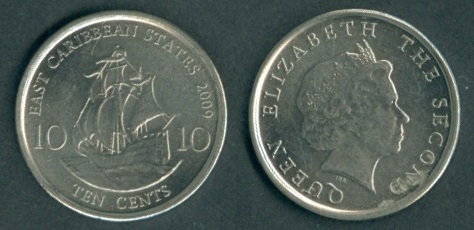 |
KM#37a
/ Schön# 36a
10
Cents. Year:
2009. Weight:
2.33g [2.30 g]. Metal:
Nickel plated Steel (magnetic).
Diameter:
17.50 mm. Edge:
Reeded. Alignment:
Medal. Mint:
Royal Canadian Mint, Ottawa,
Canada. |
|
Obverse:
"EAST CARIBBEAN STATES 2002"
written at the top section. The "Golden Hind" (1577-1600s), ship of
Sir Francis Drake (1542-1596) in the sea in the center. Numerals "10"
on left and right sides of the ship. Value "TEN CENTS" written at the bottom.
Reverse:
Portrait of Queen
Elizabeth II facing right in the center.
"QUEEN ELIZABETH THE SECOND" written around
Queen Elizabeth II's
portrait.
Mintage:
N/A.
Minted Years:
2009,
2014 and 2018. Engraver:
Thomas Humphrey Paget (Value
side) and Ian
Rank-Broadley (Queen Elizabeth II's
portrait side). |
|
| |
|
2010 |
| |
|
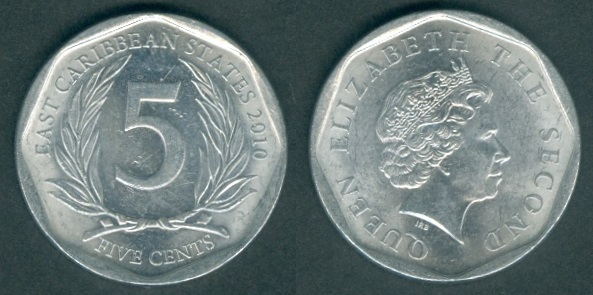 |
Same as above KM#36
Five Cents,
but...
Year: 2010.
Weight: 1.75 g
[1.75g]. Mint:
Royal Canadian Mint, Ottawa,
Canada.
Mintage:
N/A.
Note: Larger legend and spacing on
Obverse side. |
|
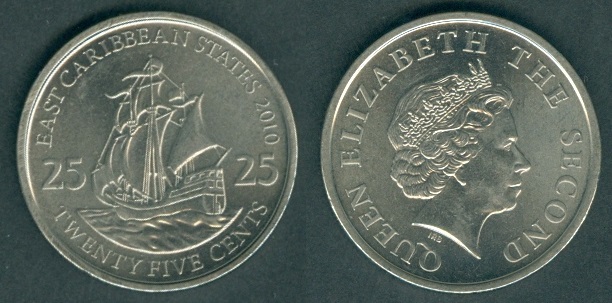 |
KM#38a
/ Schön# 39a
25
Cents. Year:
2010. Weight:
6.39g [6.48 g]. Metal:
Nickel plated Steel (magnetic).
Diameter:
23.00 mm. Edge:
Reeded. Alignment:
Medal. Mint:
Royal Canadian Mint, Ottawa,
Canada. |
|
Obverse:
"EAST CARIBBEAN STATES 2002"
written at the top section. The "Golden Hind" (1577-1600s), ship of
Sir Francis Drake (1542-1596) in the sea in the center. Numerals "25"
on left and right sides of the ship. Value "TWENTY FIVE CENTS" written at the bottom.
Reverse:
Portrait of Queen
Elizabeth II facing right in the center.
"QUEEN ELIZABETH THE SECOND" written around
Queen Elizabeth II's
portrait.
Mintage:
N/A + 5,000 Proofs.
Minted Years:
2010,
2016 and 2017. Engraver:
Thomas Humphrey Paget (Value
side) and Ian
Rank-Broadley (Queen Elizabeth II's
portrait side). |
|
| |
|
2011 |
| |
|
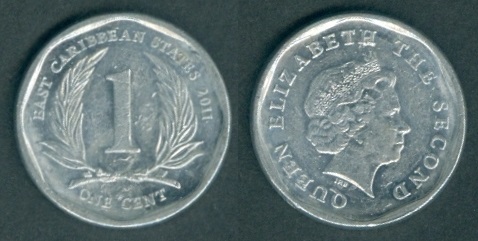 |
Same as above KM#34
One Cent,
but...
Year: 2011.
Weight: 1.04 g
[1.03g]. Mint:
Royal Canadian Mint, Ottawa,
Canada.
Mintage:
N/A.
Note: 2011 issue shows slightly
smaller lettering with distinctively smaller and thick numeral "1" in
the center on Obverse side. |
|
 |
Same as above KM#35
Two Cents,
but...
Year: 2011.
Weight: 1.42 g
[1.42g]. Mint:
Royal Canadian Mint, Ottawa,
Canada.
Mintage:
N/A. Note: 2011 issue
has smaller but broader Numeral "2" in the center on Obverse side. |
|
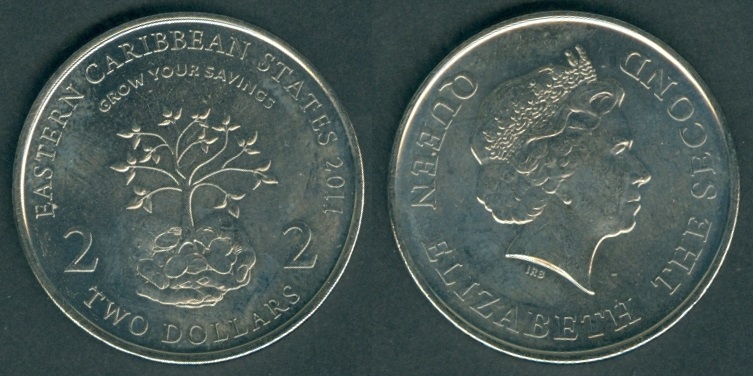 |
|
KM#87 / Schön# 86
Two Dollars. Year:
2011. Weight:
11.46g [11.35 g]. Metal:
Nickel plated steel (magnetic).
Diameter:
30.00 mm.
Thickness:
2.00 mm. Edge:
Reeded. Alignment:
Medal. Mint:
Royal Canadian Mint, Ottawa,
Canada.
Obverse:
"EASTERN CARIBBEAN STATES 2011"
written at the top section. Small Plant with 11 braches and 33
leaves with visible roots in the soil in the center. "GROW YOUR
SAVINGS" written above the plant. Numeral "2" on lower left and
lower right sides of the plant. Value "TWO DOLLARS" written at
the bottom.
Reverse:
Portrait of Queen
Elizabeth II facing right in the center.
"QUEEN ELIZABETH THE SECOND" written in the bottom section around
Queen Elizabeth II's
portrait.
Mintage:
2,000,000 (estimated).
Minted Years:
One year type. Engraver:
Ian
Rank-Broadley (Queen Elizabeth II's
portrait side).
Subject:
10th Anniversary of
Financial Information Month.
Issued Date:
17 October 2011. Circulating commemorative coin. |
|
| |
|
2012 |
| |
|
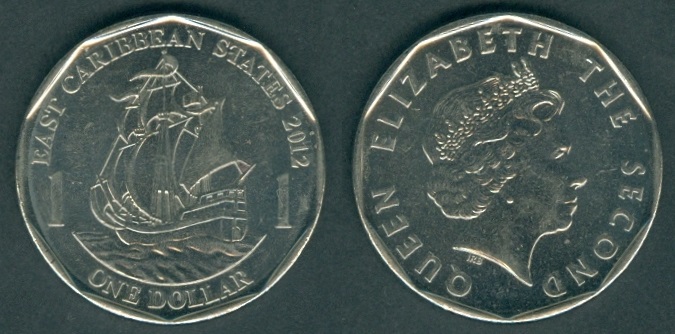 |
|
KM#39a
/ Schön# 40a
One Dollar. Year:
2012. Weight:
8.07g [7.98 g]. Metal:
Nickel plated steel (magnetic).
Diameter:
26.00 mm.
Thickness:
1.92 mm. Edge:
Reeded / Plain; 4 patches each. Alignment:
Medal. Mint:
Royal Canadian Mint, Ottawa,
Canada.
Obverse:
"EAST CARIBBEAN STATES 2012"
written at the top section. The "Golden Hind" (1577-1600s), ship of
Sir Francis Drake (1542-1596) in the sea in the center. Numeral "1"
on left and right sides of the ship. Value "ONE DOLLAR" written at the bottom.
Reverse:
Portrait of Queen
Elizabeth II facing right in the center.
"QUEEN ELIZABETH THE SECOND" written around
Queen Elizabeth II's
portrait.
Mintage:
N/A.
Minted Years: 2012,
2015, 2017 and 2019. Engraver:
Thomas Humphrey Paget (Value
side) and Ian
Rank-Broadley (Queen Elizabeth II's
portrait side). |
|
| |
|
2013 |
| |
|
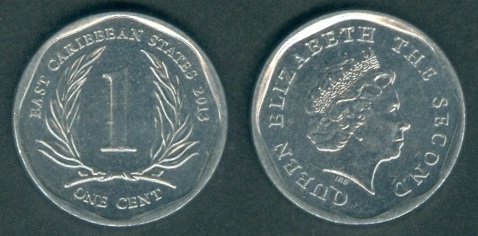 |
Same as above KM#34
One Cent,
but...
Year: 2013.
Weight: 1.05 g
[1.03g]. Mint:
Royal Canadian Mint, Ottawa,
Canada.
Mintage:
N/A.
Note: Distinctively smaller and
thick numeral "1" in the center on Obverse side. |
|
| |
|
2014 |
| |
|
 |
Same as above KM#37a
Ten Cents,
but...
Year: 2014.
Weight: 2.32 g
[2.30g]. Mint:
Royal Canadian Mint, Ottawa,
Canada.
Mintage:
N/A. |
|
| |
|
2015 |
| |
|
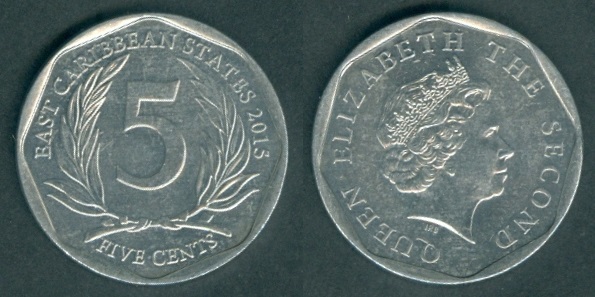 |
Same as above KM#36 Five Cents,
but...
Year: 2015.
Weight: 1.78 g
[1.75g]. Mint:
Royal Canadian Mint, Ottawa,
Canada.
Mintage:
N/A.
Note: Larger legend and spacing on
Obverse side. |
|
 |
|
Same as above KM#39a
One Dollar,
but...
Year: 2015.
Weight: 7.95 g
[7.98g]. Mint:
Royal Canadian Mint, Ottawa,
Canada.
Mintage:
N/A. |
|
-50thAnniversaryEasternCaribbeanCurrency.jpg) |
|
One Dollar. Year:
ND (2015). Weight:
7.97g [7.98 g]. Metal:
Nickel plated steel (magnetic).
Diameter:
26.00 mm.
Thickness:
1.92 mm. Edge:
Reeded / Plain; 4 patches each. Alignment:
Medal. Mint:
Royal Canadian Mint, Ottawa,
Canada.
Obverse:
"EAST CARIBBEAN STATES"
written at the top with Value "ONE DOLLAR" written below it.
Numeral "1" in Red colour above two coloured fish (Red and Aqua) in
the Aqua coloured water, in the center. "$1" written at the left
side. "LEWARD ISLANDS" and "WINDWARD ISLANDS" written clockwise
in two lines at the left side of Aqua water.
Queen Elizabeth II
facing 3/4 left at the bottom right side.
Dates "1965-2015"
written below the colour Aqua water.
Reverse:
Portrait of Queen
Elizabeth II facing right in the center.
"QUEEN ELIZABETH THE SECOND" written around
Queen Elizabeth II's
portrait.
Mintage:
1,000,000.
Minted Years:
One year type. Engraver:
Ian
Rank-Broadley (Queen Elizabeth II's
portrait side).
Subject:
50th Anniversary of Eastern Caribbean Currency 1965-2015.
Circulating commemorative coin.
Note:
Wrong spelling "LEWARD ISLANDS" instead of "LEEWARD ISLANDS"
on the coin.
Leeward Islands consists of four islands using East Caribbean
Dollar: Anguilla (UK) + Antigua and Barbuda + Montserrat (UK) +
Saint Kitts and Nevis (except the Virgin Islands). Windward Islands
also consists of four islands using this currency: Dominica + Saint
Lucia + Saint Vincent and the Grenadines + Grenada. |
|
| |
|
2016 |
| |
|
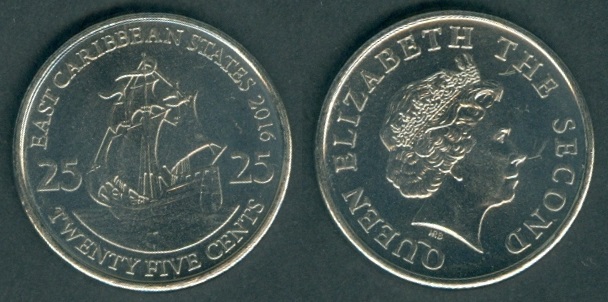 |
Same as above KM#38a
Twenty Five Cents,
but...
Year: 2016.
Weight: 6.51 g
[6.48g]. Mint:
Royal Canadian Mint, Ottawa,
Canada.
Mintage:
N/A. |
|
| |
| |
| |
|
|
| Countries
/ Territories |
| |
|
Chiefa Coins | |
|














































































-25thAnniversaryCentralBank.jpg)











-50thAnniversaryEasternCaribbeanCurrency.jpg)
